As Israel readies troops for ground assault, Gaza awaits urgently needed aid from Egypt
KHAN YOUNIS, Gaza Strip (AP) — Israel pounded the Gaza Strip with airstrikes Thursday, including in the south where Palestinians were told to take refuge, as the Israeli defense minister ordered ground troops to prepare to see Gaza “from the inside”, though he didn’t indicate when the ground assault would begin.
Gaza’s overwhelmed hospitals tried to stretch out ebbing medical supplies and fuel for generators, as authorities worked out logistics for a desperately needed aid delivery from Egypt. Doctors in darkened wards across Gaza performed surgeries by the light of mobile phones and used vinegar to treat infected wounds.
Amid the violence, President Joe Biden pledged unwavering support for Israel’s security, “today and always,” while adding that the world “can’t ignore the humanity of innocent Palestinians” in the besieged Gaza Strip.
In an address Thursday night from the Oval office, hours after returning to Washington from an urgent visit to Israel, Biden drew a distinction between ordinary Palestinians and Hamas, the militant group that controls Gaza. He linked the current war in Gaza to the Russian invasion of Ukraine, saying Hamas and Russian President Vladimir Putin “both want to completely annihilate a neighboring democracy.”
Biden said he was sending an “urgent budget request” to Congress on Friday, to cover emergency military aid to both Israel and Ukraine.
Meanwhile, an unclassified U.S. intelligence assessment delivered to Congress estimated casualties in an explosion at a Gaza City hospital this week on the “low end” of 100 to 300 deaths. The death toll “still reflects a staggering loss of life,” U.S. intelligence officials said in the report, seen by The Associated Press. It said intelligence officials were still assessing the evidence and their casualty estimate may evolve.
Biden and other U.S. officials already have said that U.S. intelligence officials believe the explosion at al-Ahli Hospital was not caused by an Israeli airstrike. Thursday’s findings echoed that.
The Israeli military has relentlessly attacked Gaza in retaliation for the devastating Oct. 7 Hamas rampage in southern Israel. Even after Israel told Palestinians to evacuate the north of Gaza and flee south, strikes extended across the territory, heightening fears among the territory’s 2.3 million people that nowhere was safe.
Palestinian militants fired rockets into Israel from Gaza and Lebanon, and tensions flared in the Israeli-occupied West Bank.
In a fiery speech to Israeli infantry soldiers on the Gaza border, Defense Minister Yoav Gallant urged the forces to “get organized, be ready” to move in. Israel has massed tens of thousands of troops along the border.
“Whoever sees Gaza from afar now, will see it from the inside,” he said. “It might take a week, a month, two months until we destroy them,” he added, referring to Hamas.
Israel’s consent for Egypt to let in food, water and medicine provided the first possible opening in its seal of the territory. Many Gaza residents are down to one meal a day and drinking dirty water.
Egypt and Israel were still negotiating the entry of fuel for hospitals. Israeli military spokesman Rear Adm. Daniel Hagari said Hamas has stolen fuel from U.N. facilities and Israel wants assurances that won’t happen. The first trucks of aid were expected to go in Friday.
With the Egypt-Gaza border crossing in Rafah closed, the already dire conditions at Gaza’s second-largest hospital deteriorated further, said Dr. Mohammed Qandeel of Nasser Hospital in the southern town of Khan Younis. Power was shut off in most of the hospital and medical staff were using mobile phones for light.
At least 80 wounded civilians and 12 dead flooded into the hospital after witnesses said a strike hit a residential building in Khan Younis. Doctors had no choice but to leave two to die because there were no ventilators, Qandeel said.
“We can’t save more lives if this keeps happening,” he said.
The Gaza Health Ministry pleaded with gas stations to give fuel to hospitals and a U.N. agency donated some of its last fuel.
The agency’s donation to Gaza City’s Shifa Hospital, the territory’s largest, would “keep us going for another few hours,” hospital director Mohammed Abu Selmia said.
Al-Ahli Hospital was still recovering from Tuesday’s explosion, which remains a point of dispute between Hamas and Israel. Hamas quickly said an Israeli airstrike hit the hospital, which Israel denied. The AP has not independently verified any of the claims or evidence released by the parties.
The blast left body parts strewn on the hospital grounds, where crowds of Palestinians had clustered in hopes of escaping Israeli airstrikes. The U.S. assessment noted “only light structural damage,” with no impact crater visible.
Near al-Ahli, meanwhile, another explosion struck a Greek Orthodox church housing displaced Palestinians late Thursday, resulting in deaths and dozens of wounded. Abu Selmia, the Shifa Hospital director general, said dozens were hurt at the Church of Saint Porphyrios but could not give a precise death toll because bodies were buried under rubble.
Palestinian authorities blamed the blast on an Israeli airstrike, a claim that could not be independently verified. The Greek Orthodox Patriarchy of Jerusalem condemned the attack and said it would “not abandon its religious and humanitarian duty” to provide assistance.
The Gaza Health Ministry said 3,785 people have been killed in Gaza since the war began, the majority women, children and older adults. Nearly 12,500 were injured, and another 1,300 people were believed buried under rubble, authorities said.
More than 1,400 people in Israel have been killed, mostly civilians slain during Hamas’ deadly incursion. Roughly 200 others were abducted. The Israeli military said Thursday it had notified the families of 203 captives.
More than 1 million Palestinians, about half of Gaza’s population, have fled their homes in the north since Israel told them to evacuate, crowding into U.N.-run schools-turned-shelters or the homes of relatives.
For the first time since Israel captured Gaza from Egypt in 1967, a major tent camp arose to house displaced people. Dozens of U.N.-provided tents lined a dirt lot in Khan Younis.
The deal to get aid into Gaza through Rafah, the territory’s only connection to Egypt, remained fragile. Israel said the supplies could only go to civilians and that it would “thwart” any diversions by Hamas. Biden said the deliveries “will end” if Hamas takes any aid.
More than 200 trucks and some 3,000 tons of aid were positioned at or near Rafah, according to Khalid Zayed, the head of the Red Crescent for North Sinai.
Under an arrangement reached between the United Nations, Israel and Egypt, U.N. observers will inspect the trucks before entering Gaza. The U.N., working with the Egyptian and Palestinian Red Crescent, will ensure aid goes only to civilians, an Egyptian official and European diplomat told the AP. A U.N. flag will be raised on both sides of the crossing as a sign of protection against airstrikes, said the officials, who spoke on condition of anonymity because they were not authorized to brief media.
It was not immediately clear how much cargo the crossing could handle. Waleed Abu Omar, spokesperson for the Palestinian side, said work has not started to repair the road damaged by Israeli airstrikes.
Egyptian Foreign Minister Sameh Shoukry told Al-Arabiya TV that foreigners and dual nationals would be allowed to leave Gaza once the crossing was opened.
Israel said it agreed to allow aid from Egypt because of a request by Biden — which followed days of intense talks with the U.S. secretary of state to overcome staunch Israeli refusal.
Israel had previously said it would let nothing into Gaza until Hamas freed the hostages taken from Israel. Relatives of some of the captives were furious over the aid announcement.
“The Israeli government pampers the murderers and kidnappers,” the Hostage and Missing Families Forum said.
The Israeli military said Thursday it killed a top Palestinian militant in Rafah and hit hundreds of targets across Gaza, including militant tunnel shafts, intelligence infrastructure and command centers. Palestinians have launched barrages of rockets at Israel since the fighting began.
Violence was also escalating in the West Bank, where Israel carried out a rare airstrike Thursday, targeting militants in the Nur Shams refugee camp.
Six Palestinians were killed, the Palestinian Health Ministry said, and the Israeli military said the strike killed militants and resulted in 10 Israeli officers being wounded. More than 74 Palestinians have been killed in the West Bank since the war started.
__
Nessman reported from Jerusalem and Kullab from Baghdad. Associated Press journalists Amy Teibel and Isabel Debre in Jerusalem; Samy Magdy and Jack Jeffrey in Cairo; Matthew Lee and Mary Clare Jalonick in Washington, and Ashraf Sweilam in el-Arish, Egypt, contributed to this report.
Copyright © 2023 The Associated Press. All rights reserved. This material may not be published, broadcast, written or redistributed.The Associated Press
October 19, 2023
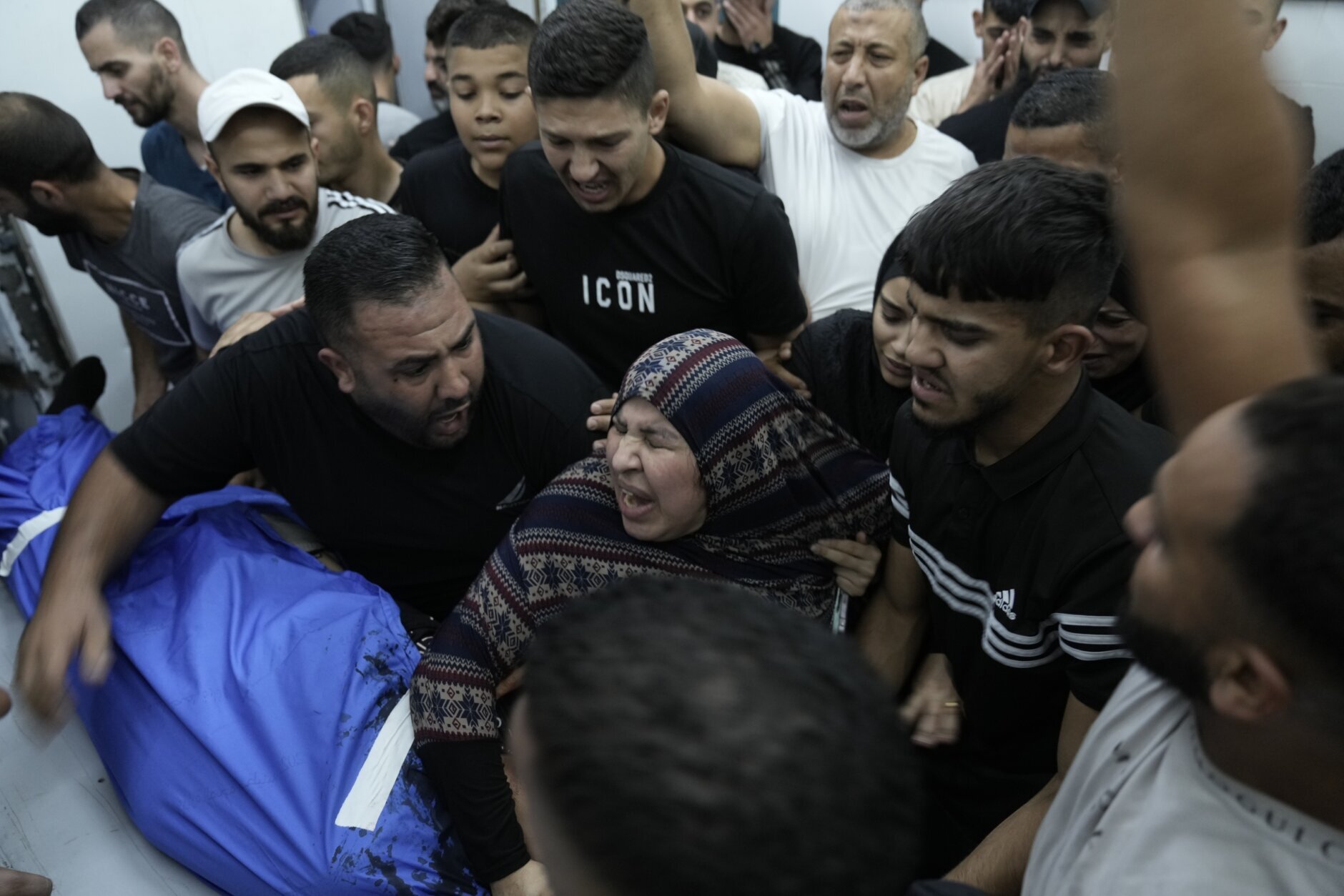
Israel Palestinians Relatives mourn Palestinian boy Ali Abu Khazna, who was killed during an Israeli army raid on Nur Shams refugee camp, in a morgue in Tulkarem, West Bank, Thursday, Oct. 19, 2023. (AP Photo/Majdi Mohammed)
AP Photo/Majdi Mohammed
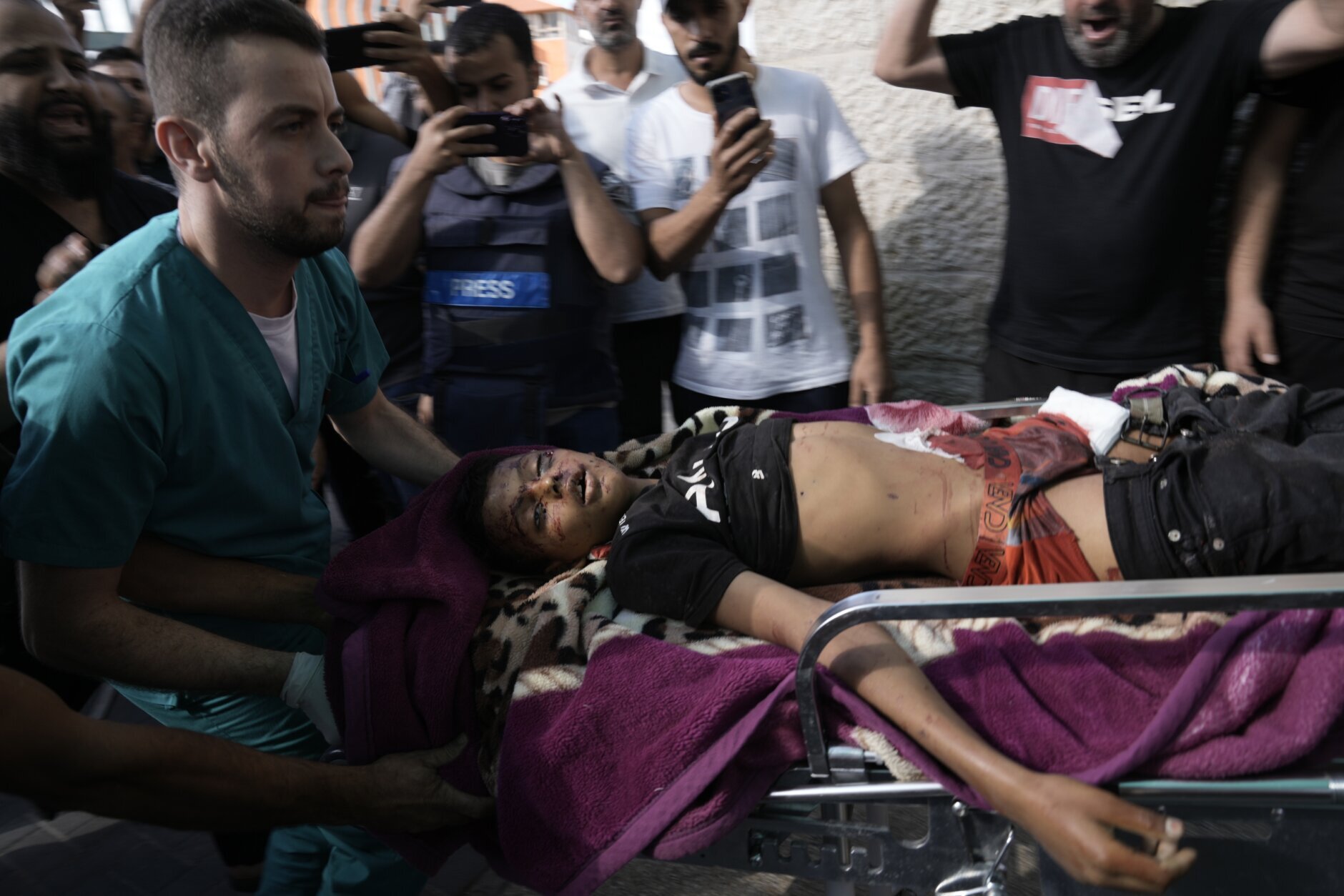 I
I srael Palestinians A Palestinian boy wounded in an Israeli army raid on Nur Shams refugee camp is brought to a hospital in Tulkarem, West Bank, on Thursday, Oct. 19, 2023. (AP Photo/Majdi Mohammed)
AP Photo/Majdi Mohammed
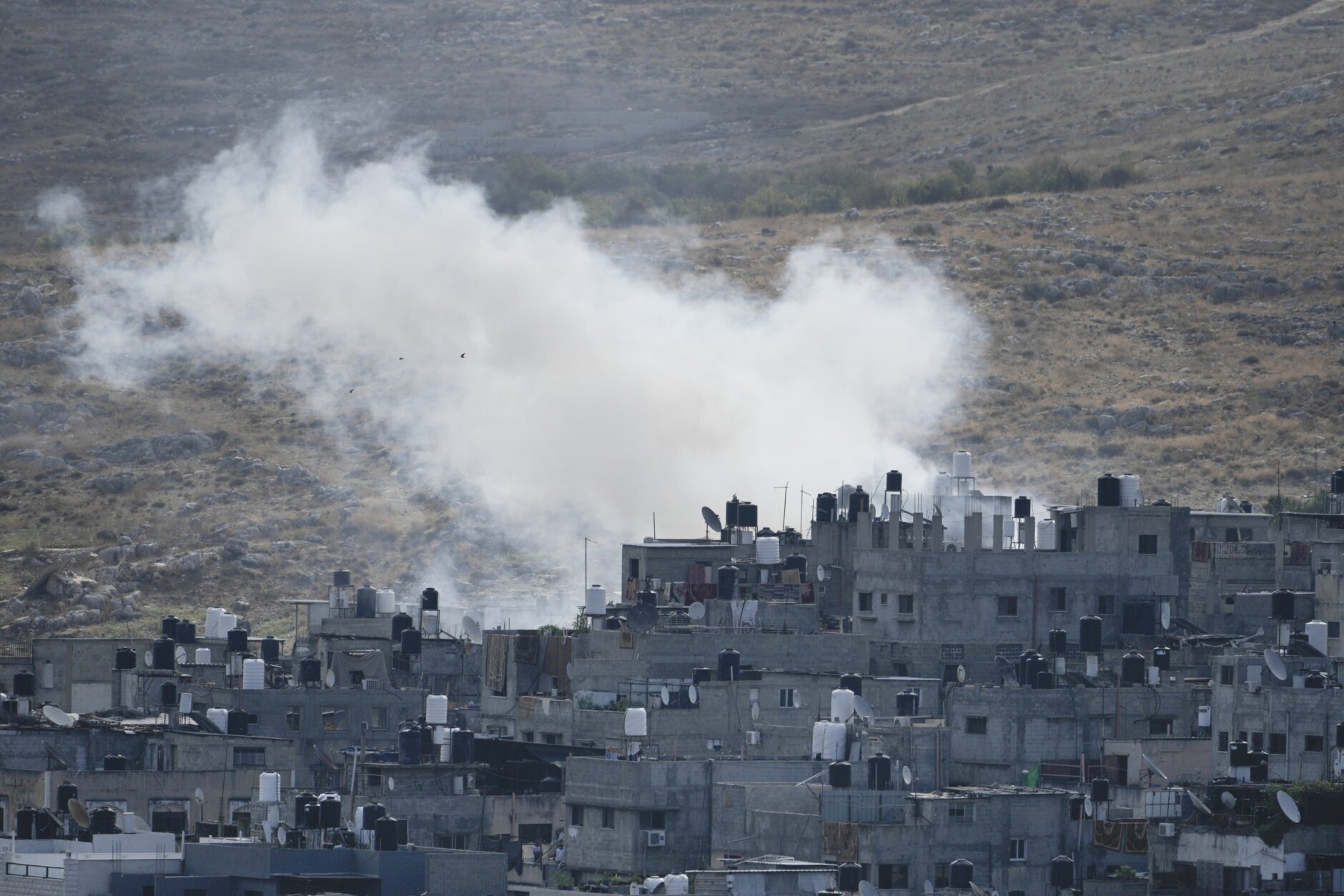
Israel Palestinians Smoke rises from Nur Shams refugee camp during an Israeli military raid West Bank on Thursday, Oct. 19, 2023. (AP Photo/Majdi Mohammed)
AP Photo/Majdi Mohammed
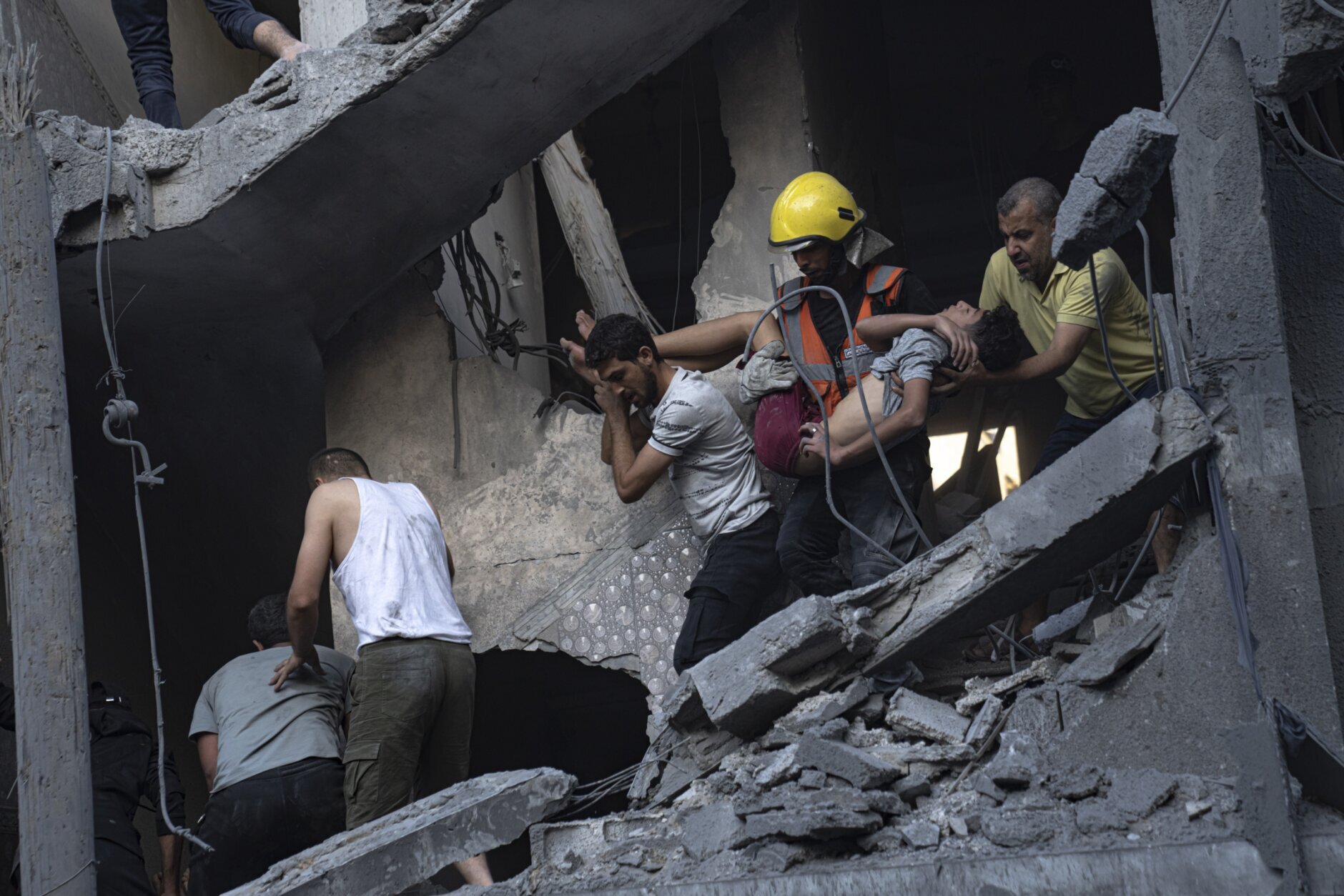
Palestinians Israel Palestinians evacuate wounded from a building destroyed in Israeli bombardment in Khan Younis, Gaza Strip, Thursday, Oct. 19, 2023. (AP Photo/Fatima Shbair)
AP Photo/Fatima Shbair
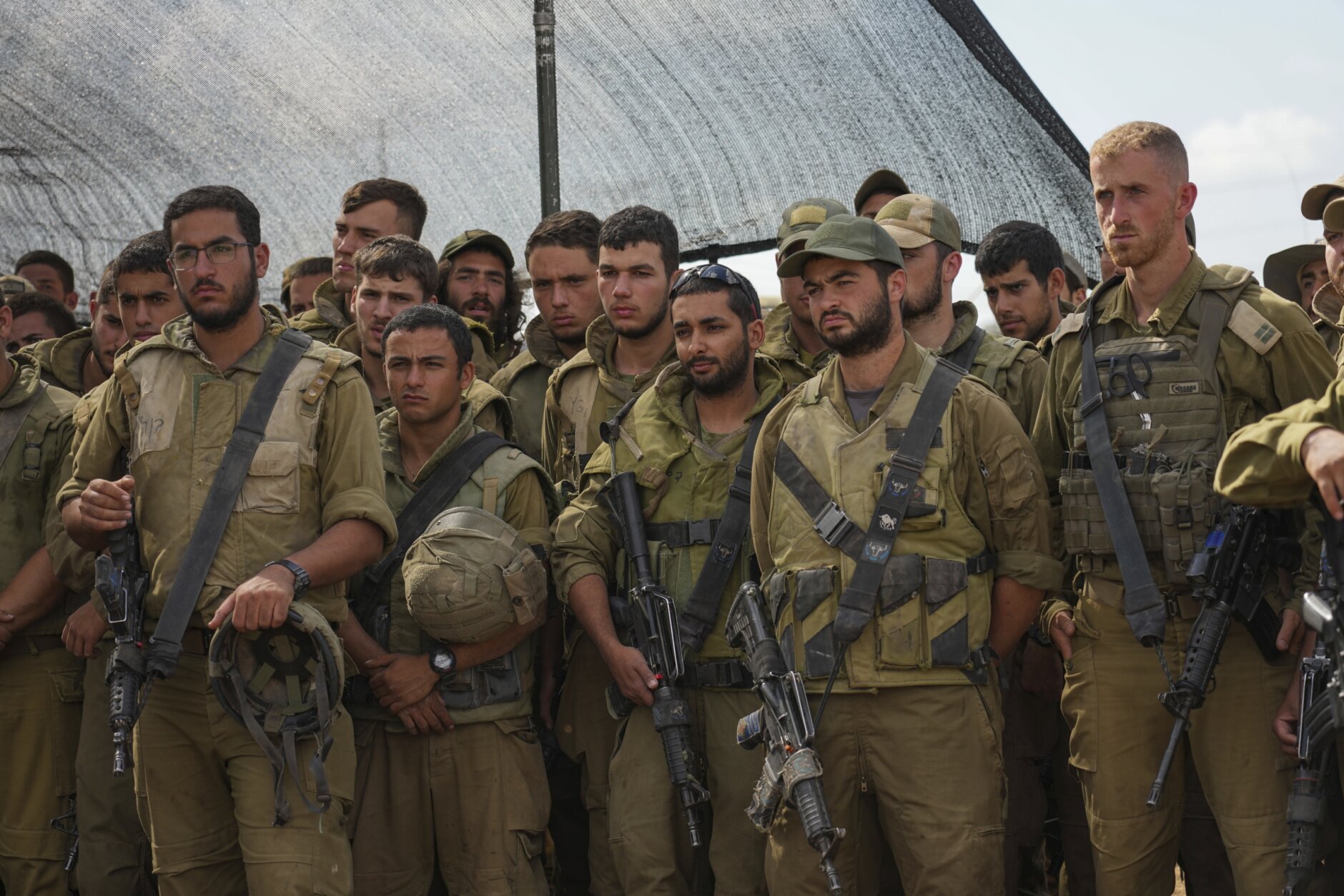
Israel Palestinians Israeli soldiers listen to Israel's Defense Minister Yoav Gallant, during his visit to a staging area near the border with the Gaza Strip in southern Israel, Thursday, Oct. 19, 2023. (AP Photo/Tsafrir Abayov)
AP Photo/Tsafrir Abayov
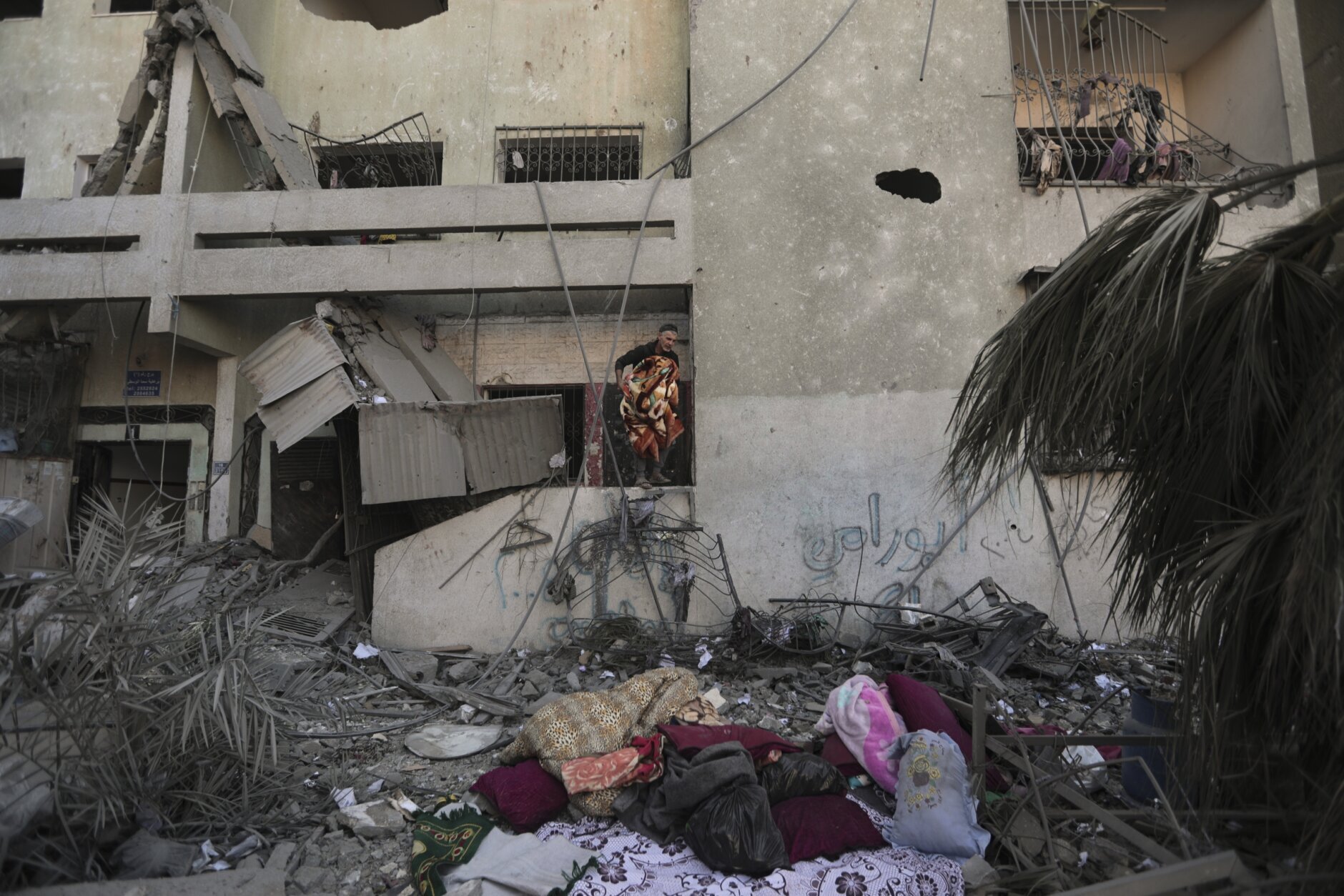
Israel Palestinians Palestinians try to salvage what they can of belongings from the rubble a destroyed building, following Israeli airstrikes on Gaza City, central Gaza Strip, Thursday, Oct. 19, 2023. (AP Photo/Mohammed Dahman)
AP Photo/Mohammed Dahman
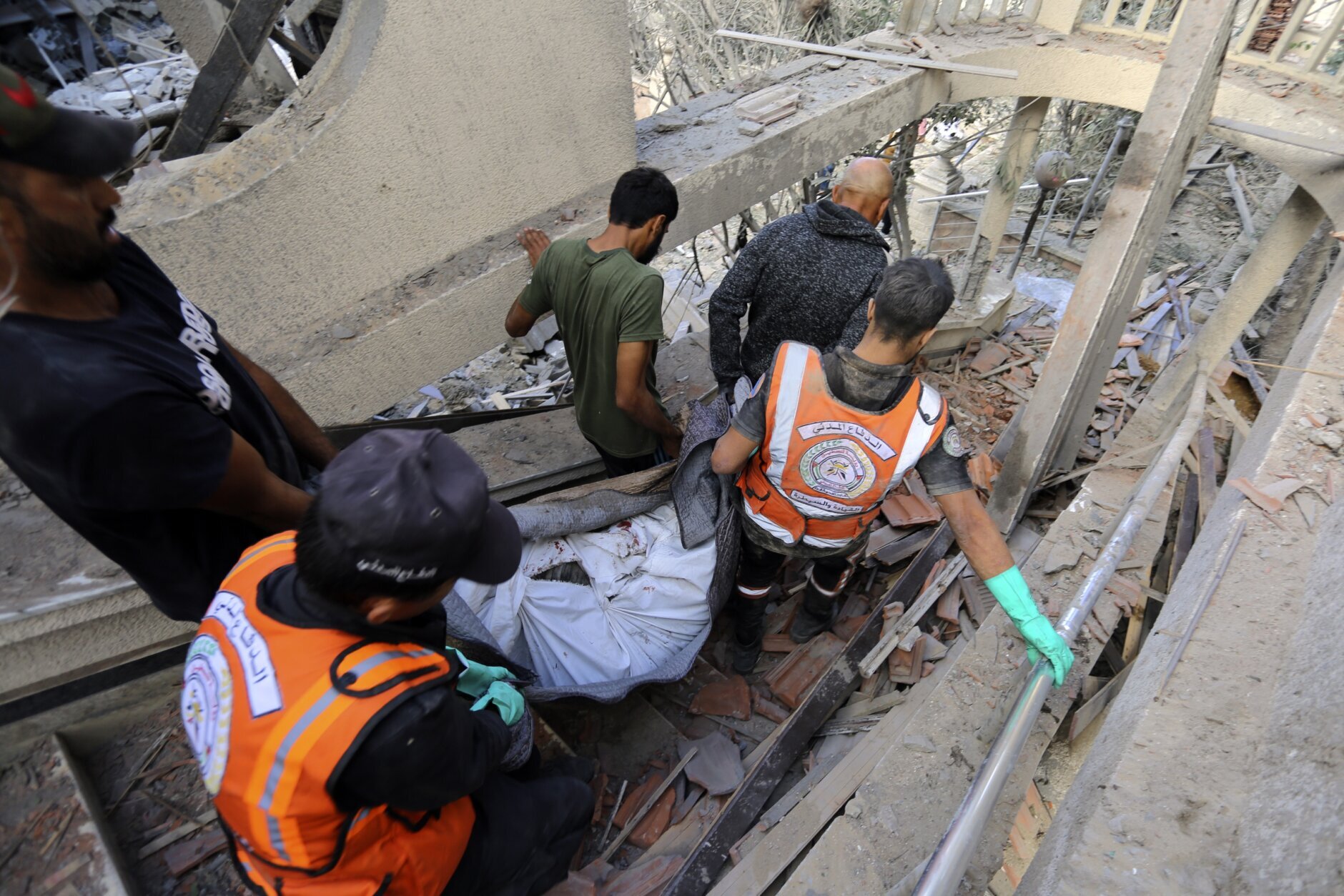
Israel Palestinians Palestinians carry the lifeless body of a man found inside a destroyed house following Israeli airstrikes on Gaza City, Thursday, Oct.19, 2023. (AP Photo/Abed Khaled)
AP Photo/Abed Khaled
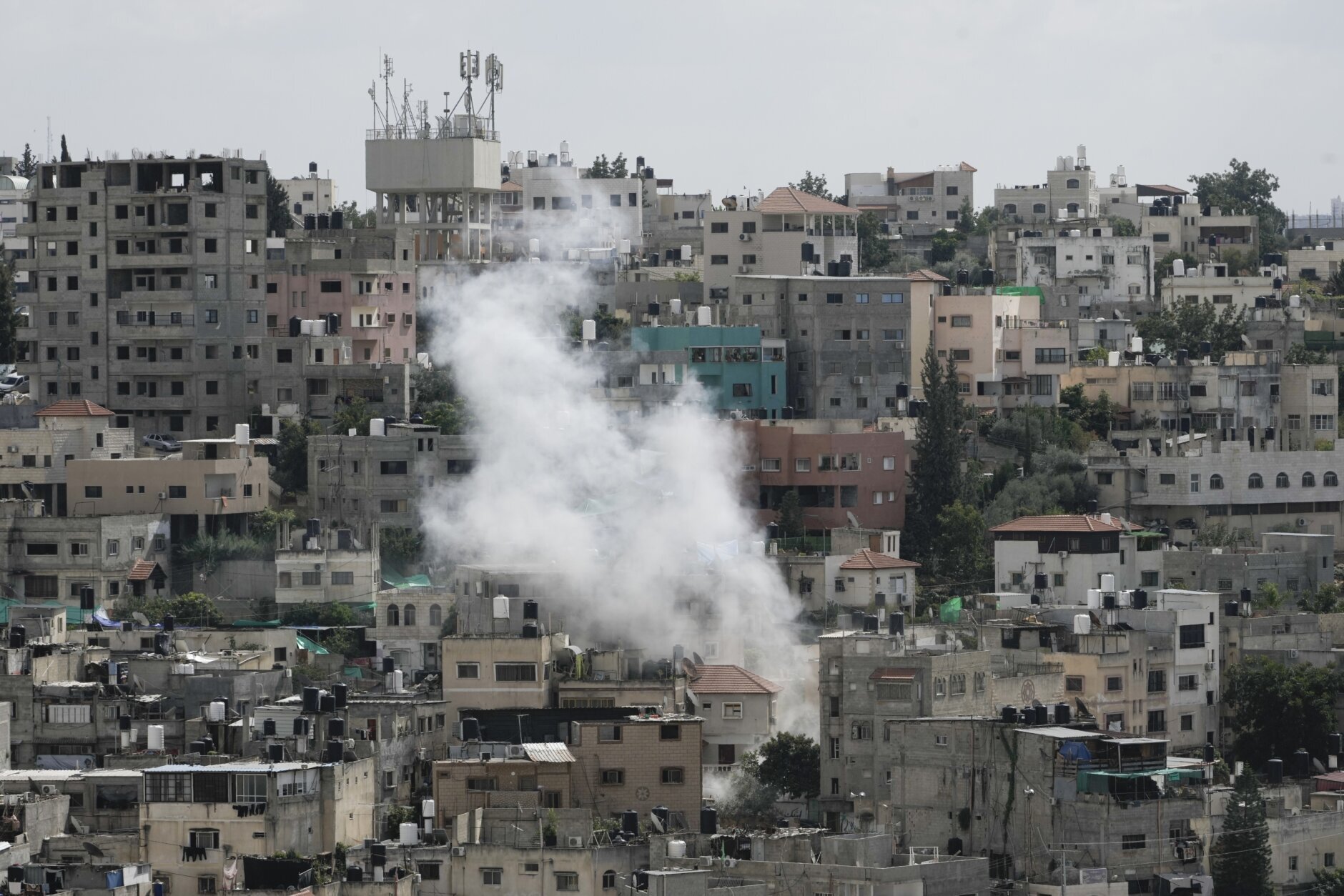
Israel Palestinians Smoke rises during an Israeli military raid on Nur Shams, West Bank, on Thursday, Oct. 19, 2023. (AP Photo/Majdi Mohammed)
AP Photo/Majdi Mohammed
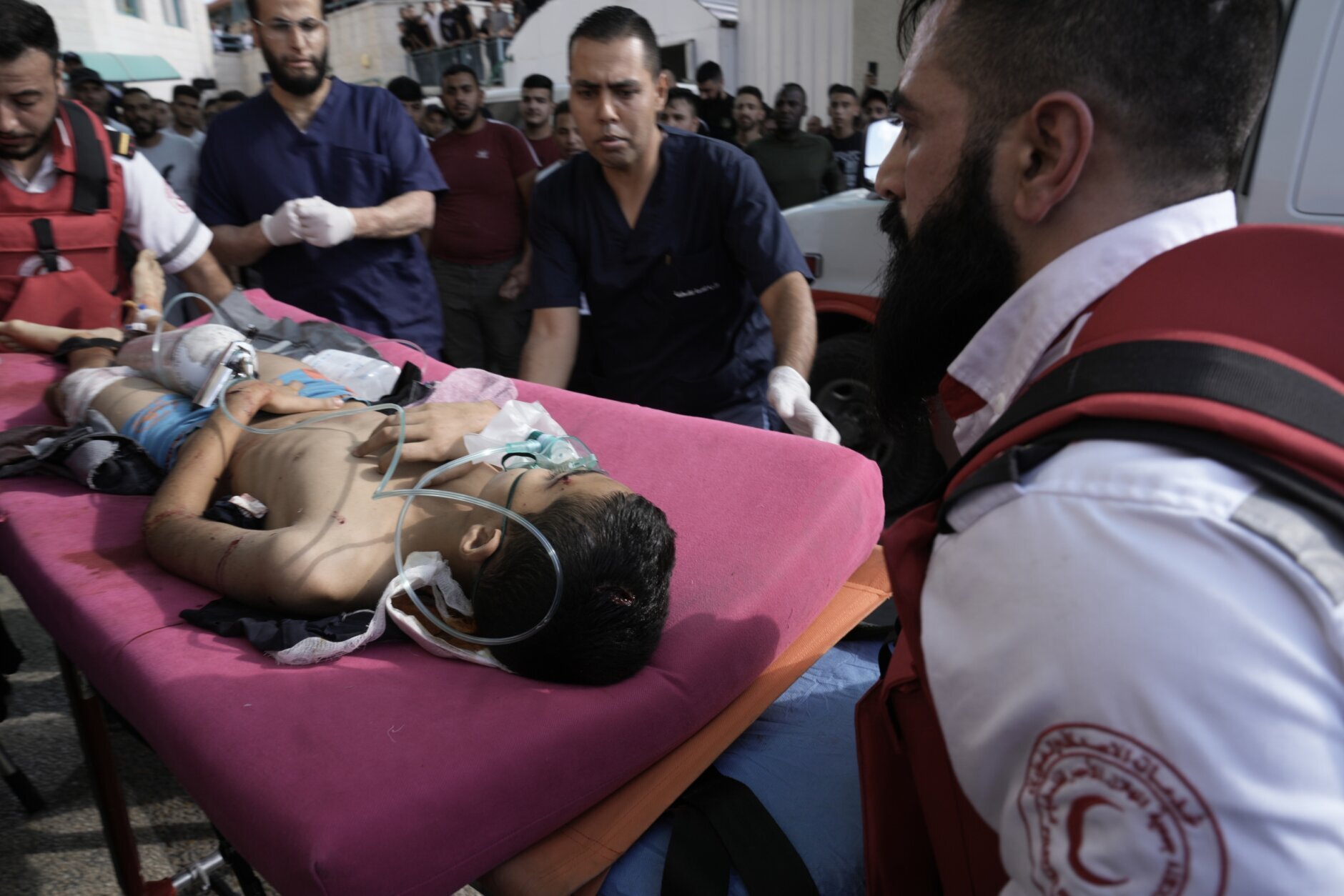
Israel Palestinians A Palestinian boy wounded in an Israeli army raid on Nur Shams refugee camp is brought to a hospital in Tulkarem, West Bank, on Thursday, Oct. 19, 2023. (AP Photo/Majdi Mohammed)
AP Photo/Majdi Mohammed
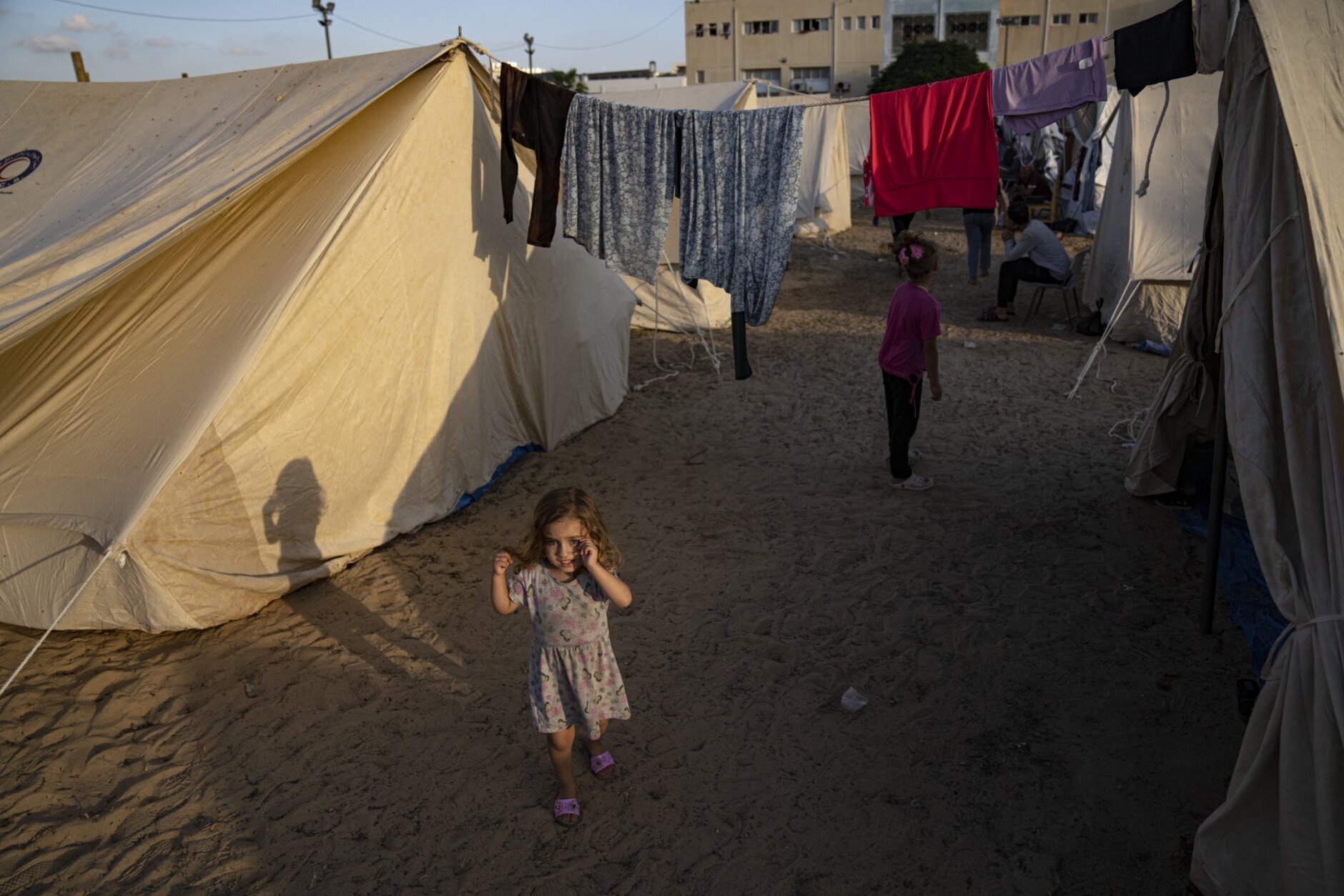
Israel Palestinians Palestinian children displaced by the Israeli bombardment of the Gaza Strip walk in a UNDP-provided tent camp in Khan Younis on Thursday, Oct. 19, 2023. (AP Photo/Fatima Shbair)
AP Photo/Fatima Shbair
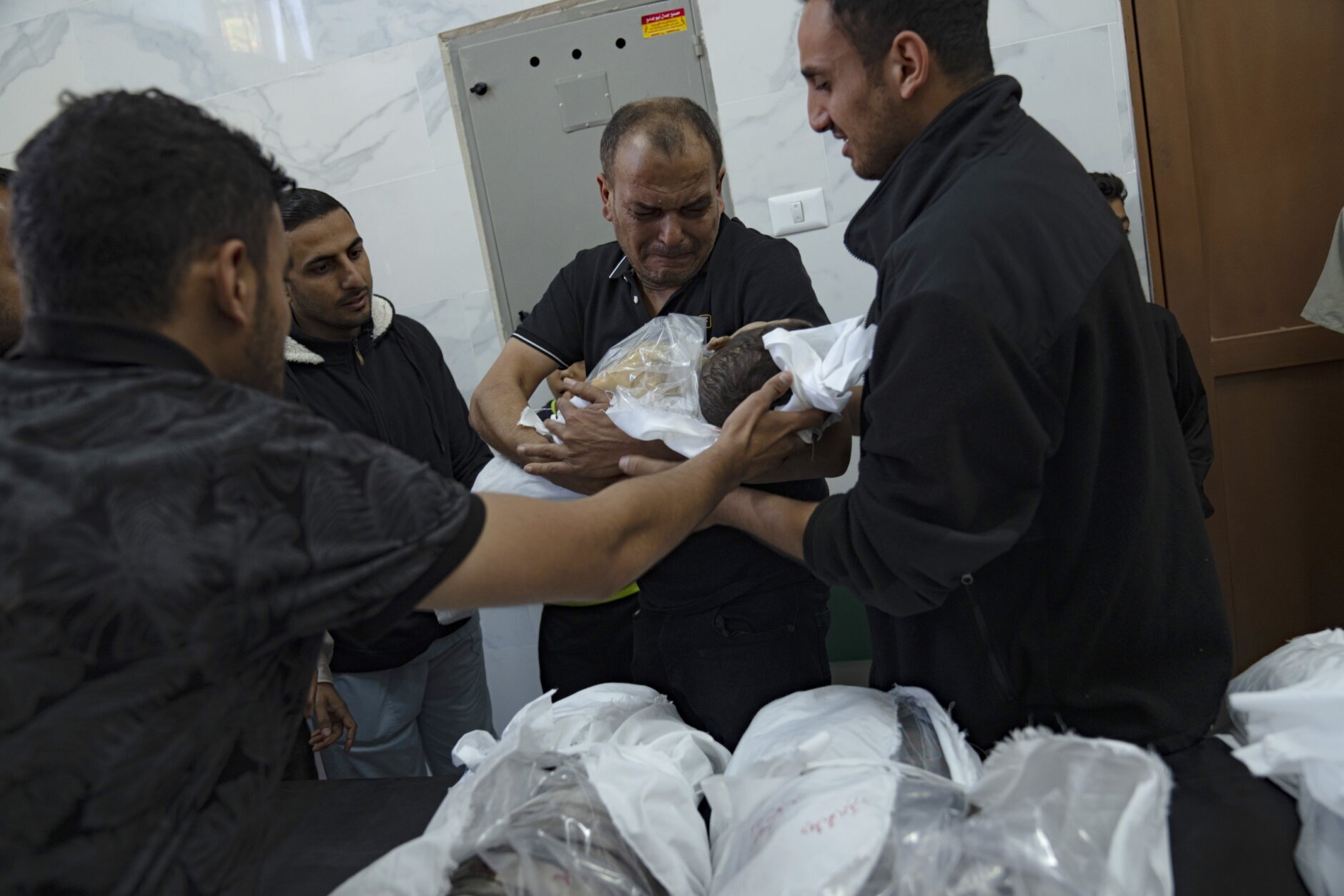
Palestinians Israel A Palestinian man holds the body of his nephew killed in the Israeli bombardment of the Gaza Strip, during his funeral in Khan Younis, Thursday, Oct. 19, 2023. (AP Photo/Fatima Shbair)
AP Photo/Fatima Shbair
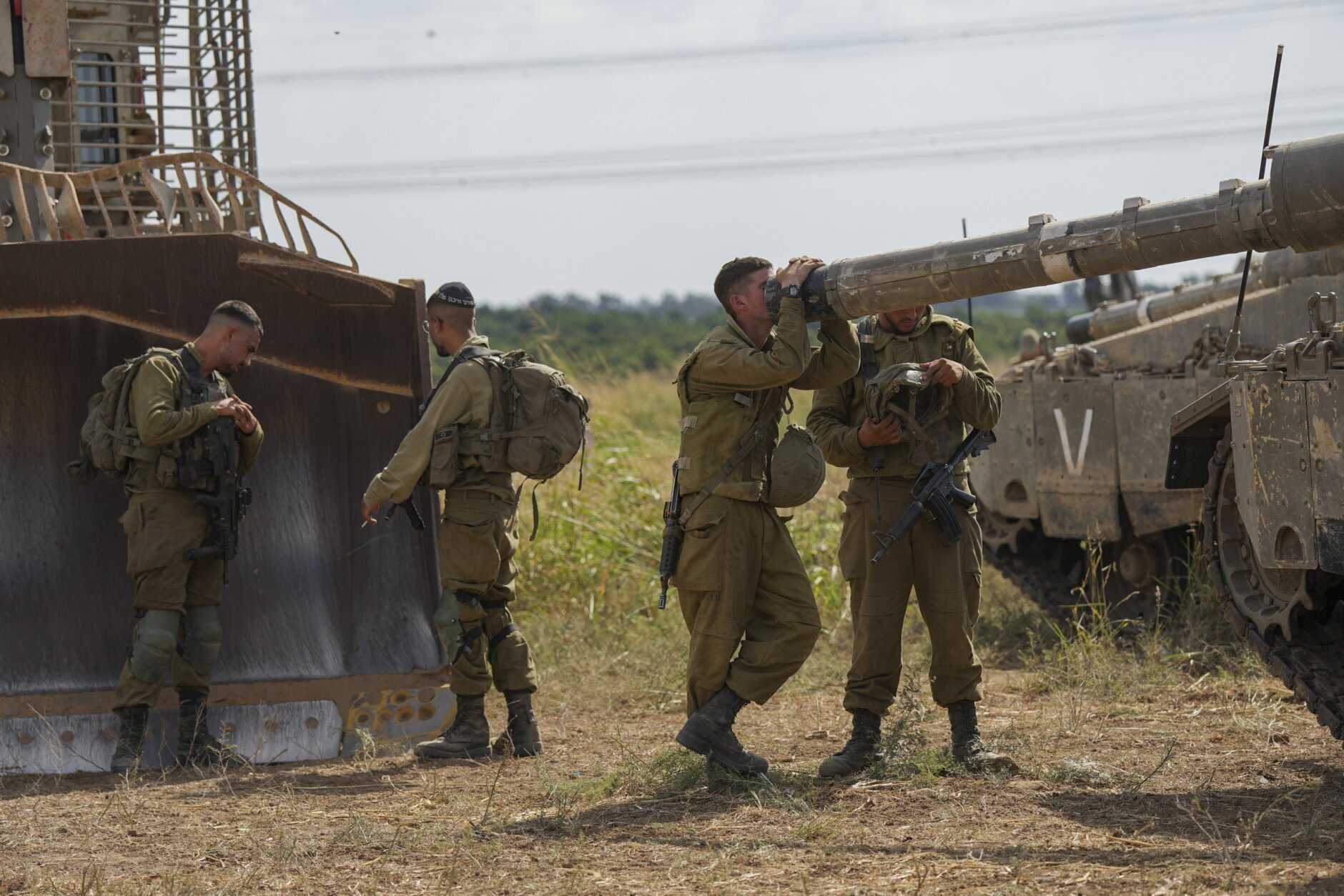
Israel Palestinians Israeli soldiers gather in a staging area near the border with Gaza Strip, in southern Israel, Thursday, Oct. 19, 2023. (AP Photo/Tsafrir Abayov)
AP Photo/Tsafrir Abayov
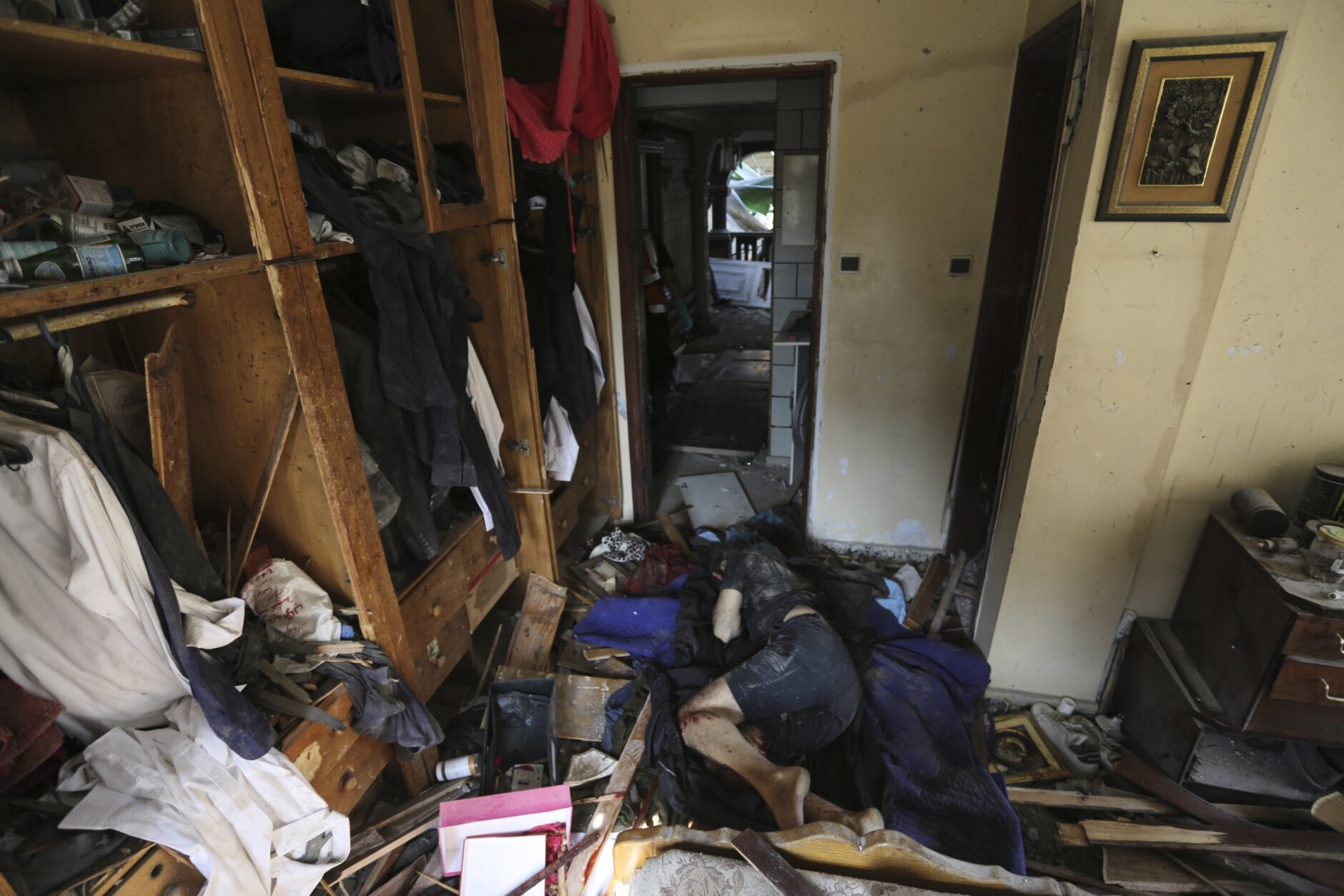
Israel Palestinians The body of a dead Palestinian is found inside a destroyed house following Israeli airstrikes on Gaza City, Thursday, Oct.19, 2023. (AP Photo/Abed Khaled)
AP Photo/Abed Khaled
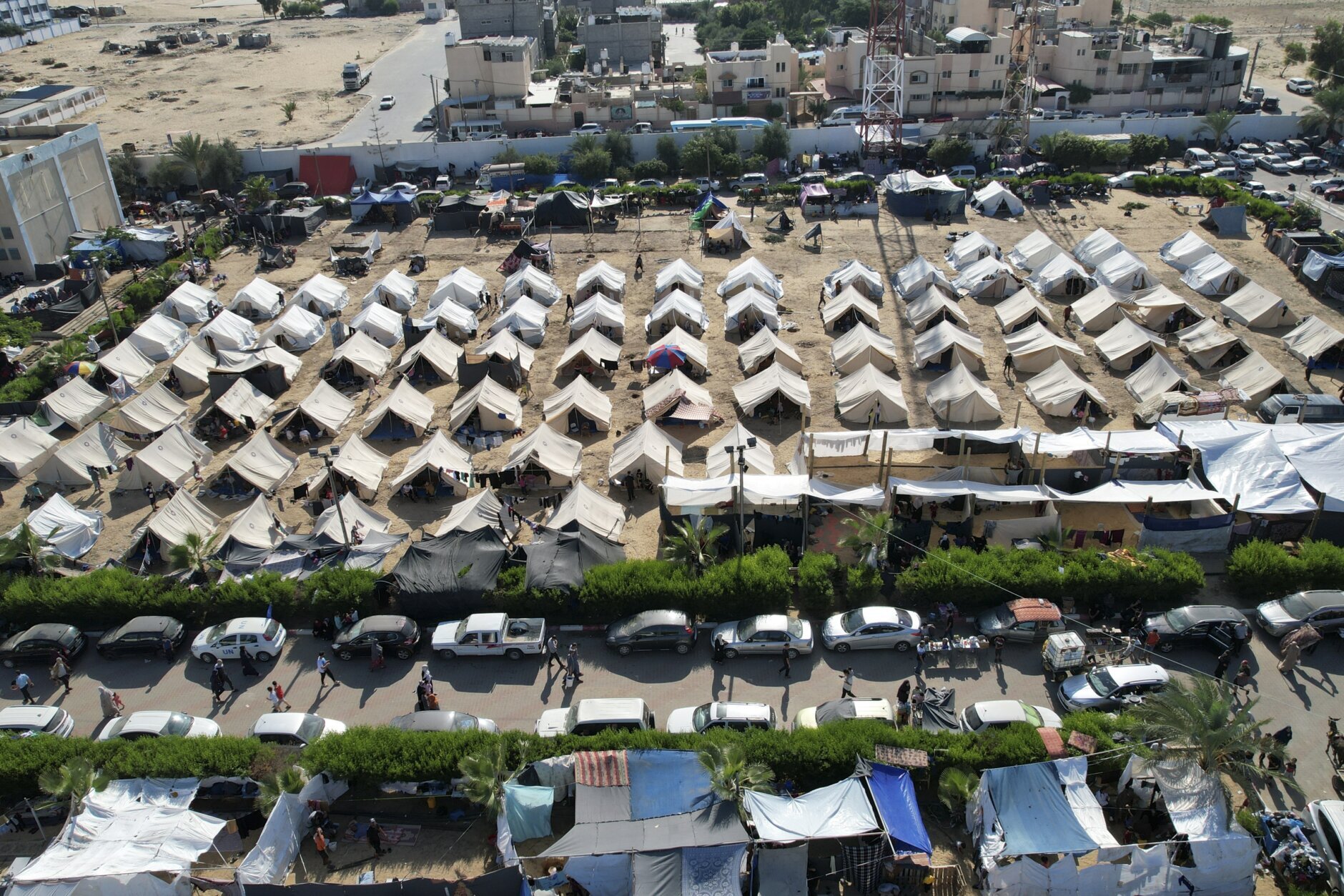
Israel Palestinians UNDP provided tens set up for Palestinians displaced by the Israeli bombardment of the Gaza Strip, are seen in Khan Younis on Thursday, Oct. 19, 2023. (AP Photo/Ashraf Amra)
AP Photo/Ashraf Amra
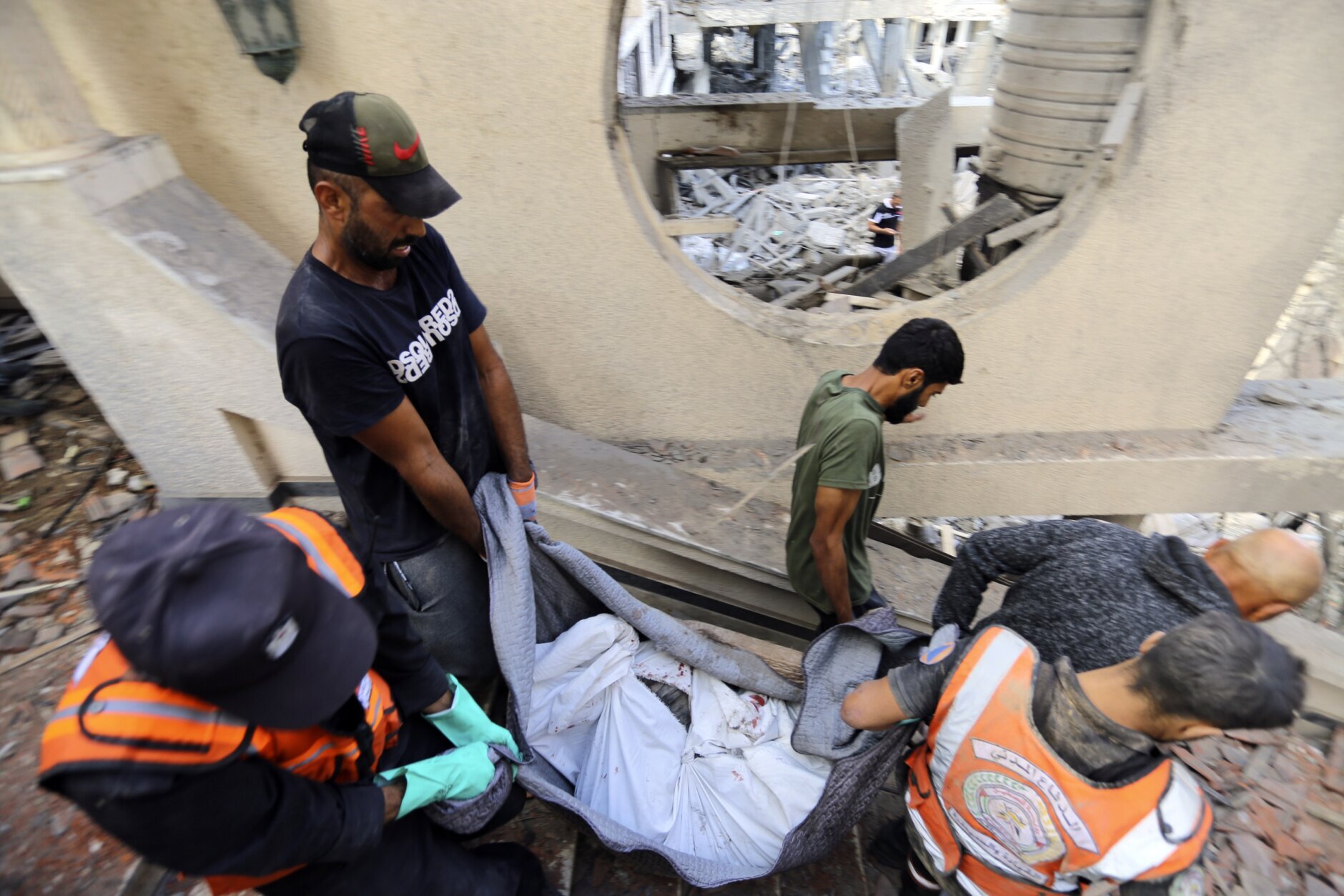
Israel Palestinians Palestinians carry the lifeless body of a man found inside a destroyed house following Israeli airstrikes on Gaza City, Thursday, Oct.19, 2023. (AP Photo/Abed Khaled)
AP Photo/Abed Khaled
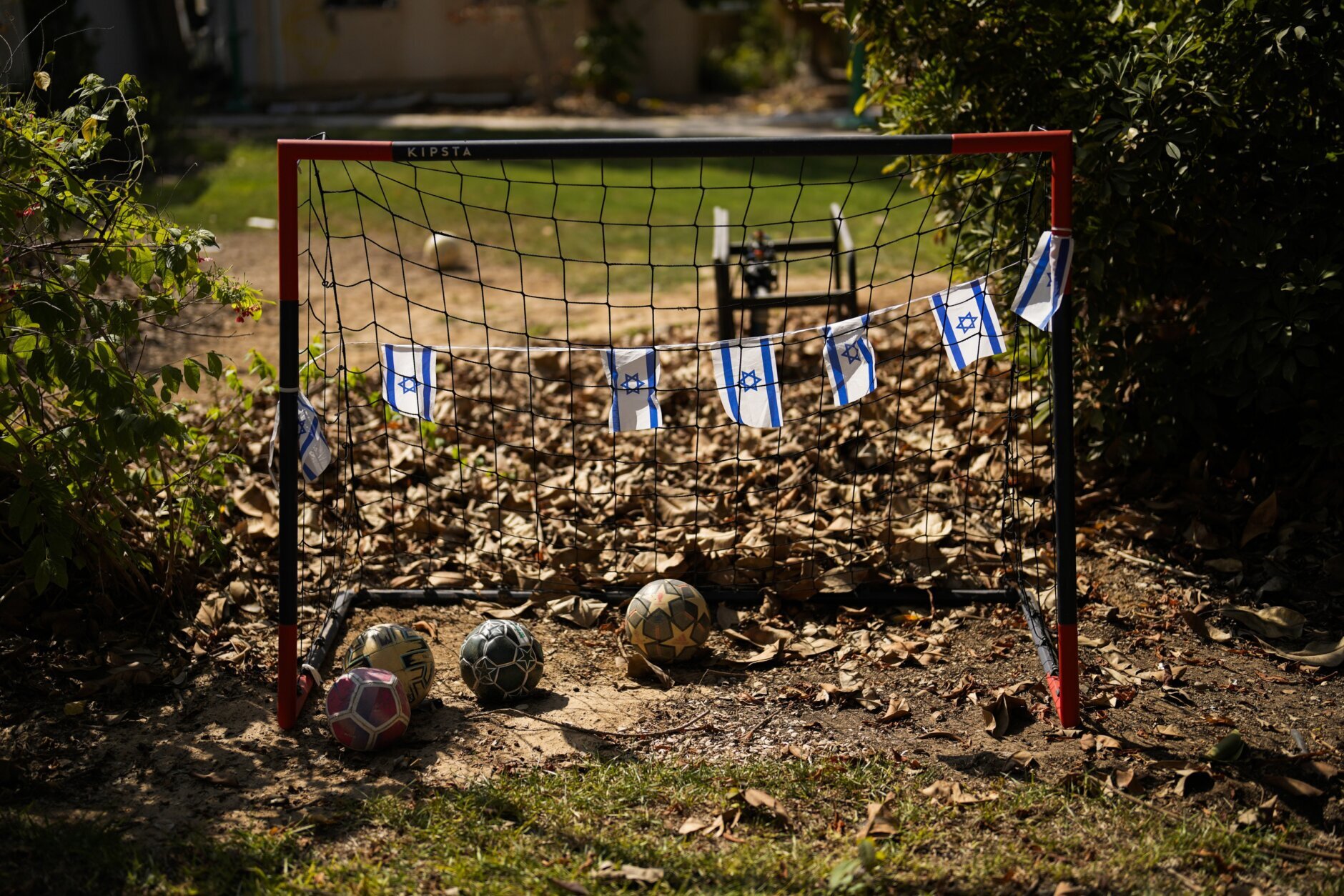
Israel Palestinians Israel flags hang in a soccer goal in a backyard of a home that came under attack during a massive Hamas invasion into Kibbutz Nir Oz, Israel, Thursday, Oct. 19, 2023. The small farming community in the south of Israel was overrun by Hamas fighters from the nearby Gaza Strip who killed 1,400 Israelis and captured dozens of others on Oct. 7. (AP Photo/Francisco Seco)
AP Photo/Francisco Seco
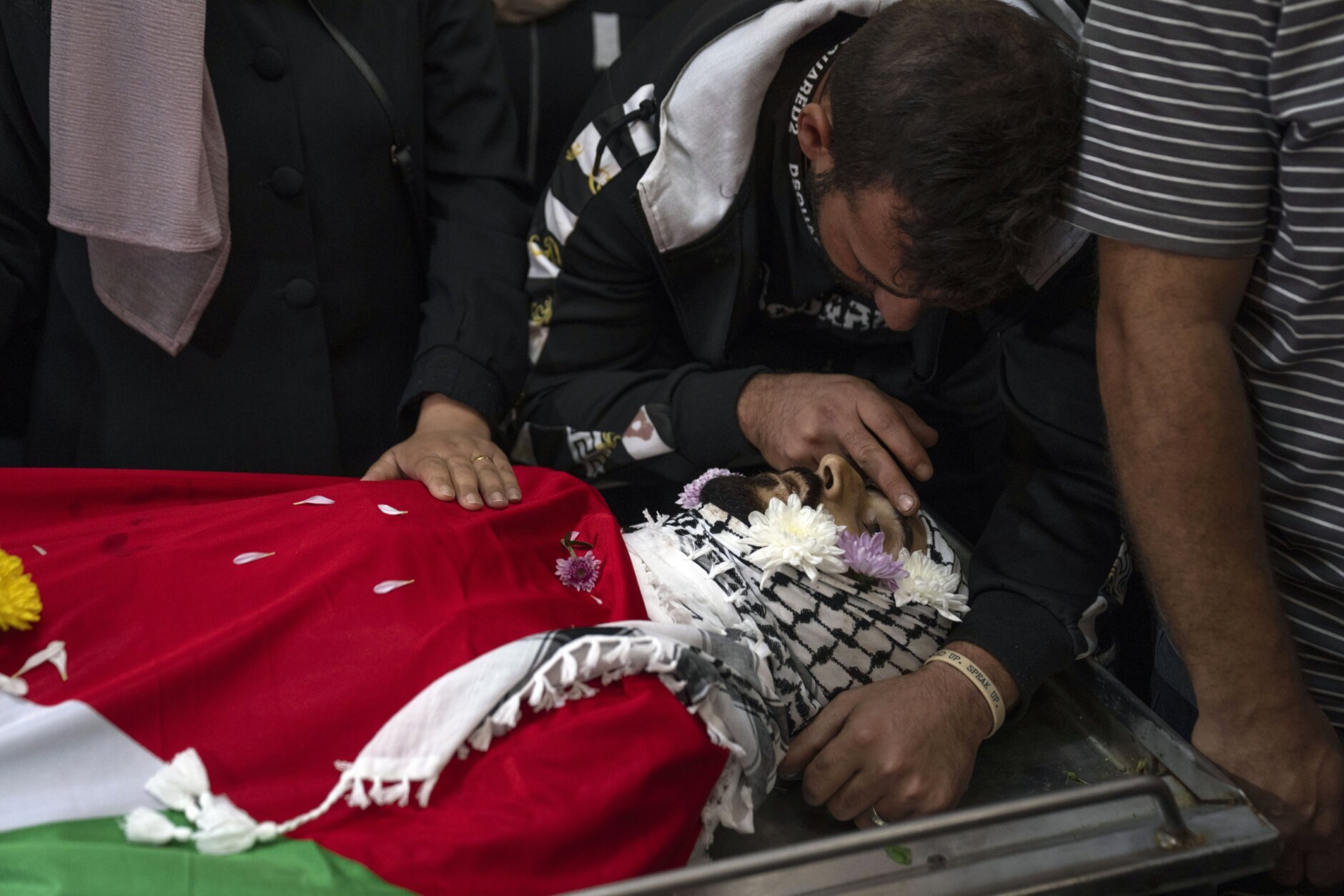
Israel Palestinians Mourners take the last look at the Bodies of Ibrahim Awad, and Mohammad Fawaqa, not pictured, during their funeral in the West Bank city of Ramallah, Thursday, Oct. 19, 2023. Awad was killed during clashes with Israeli settlers near his home village of Dura al-Qara' and Fawaqa was killed during an Israeli army raid in the village of Qebia, west of Ramallah, while two other Palestinians were killed during Israeli army raids early morning in the occupied West Bank, Palestinian ministry of health said. (AP Photo/Nasser Nasser)
AP Photo/Nasser Nasser
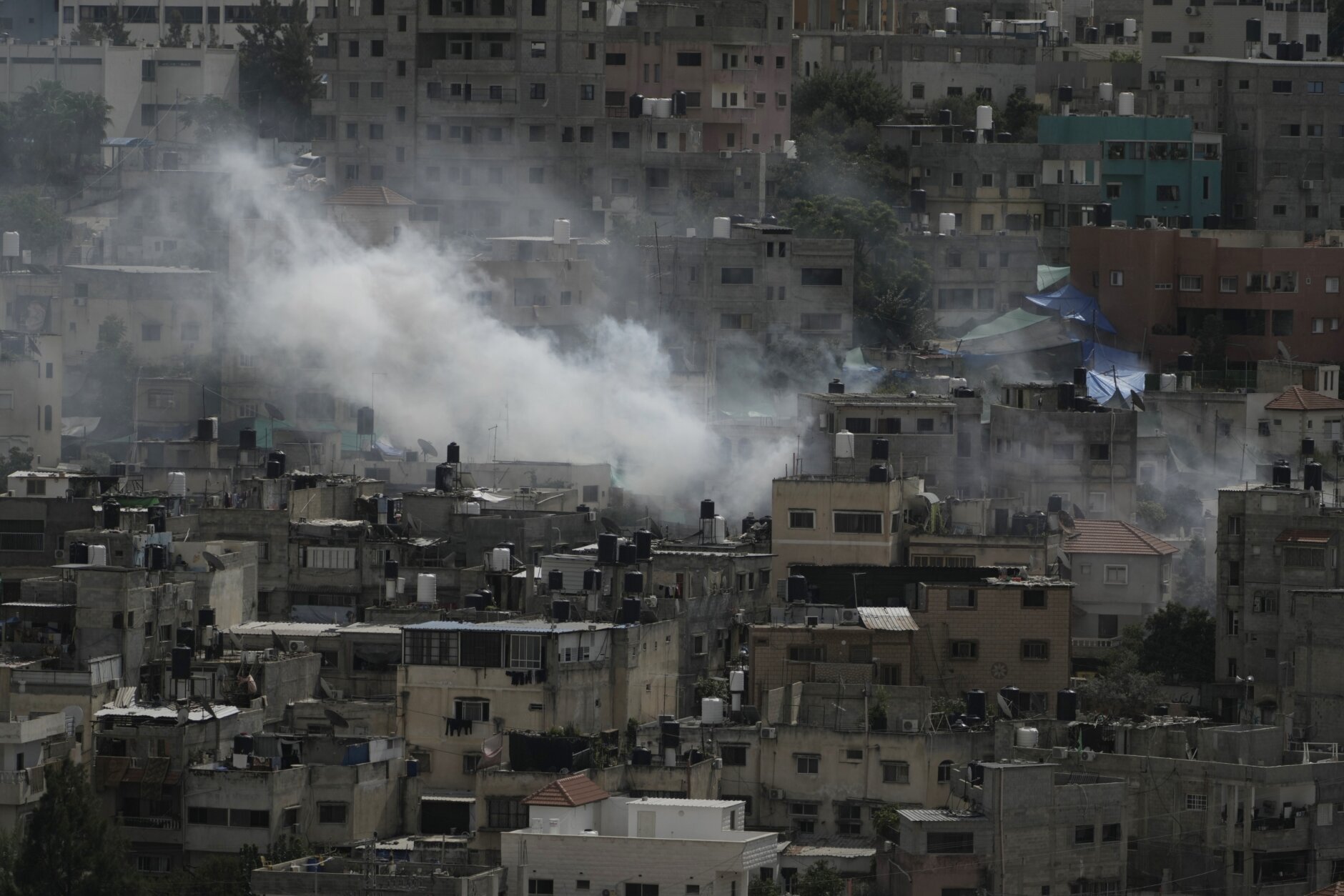
Israel Palestinians Smoke rises during an Israeli military raid on Nur Shams, West Bank, on Thursday, Oct. 19, 2023. (AP Photo/Majdi Mohammed)
AP Photo/Majdi Mohammed
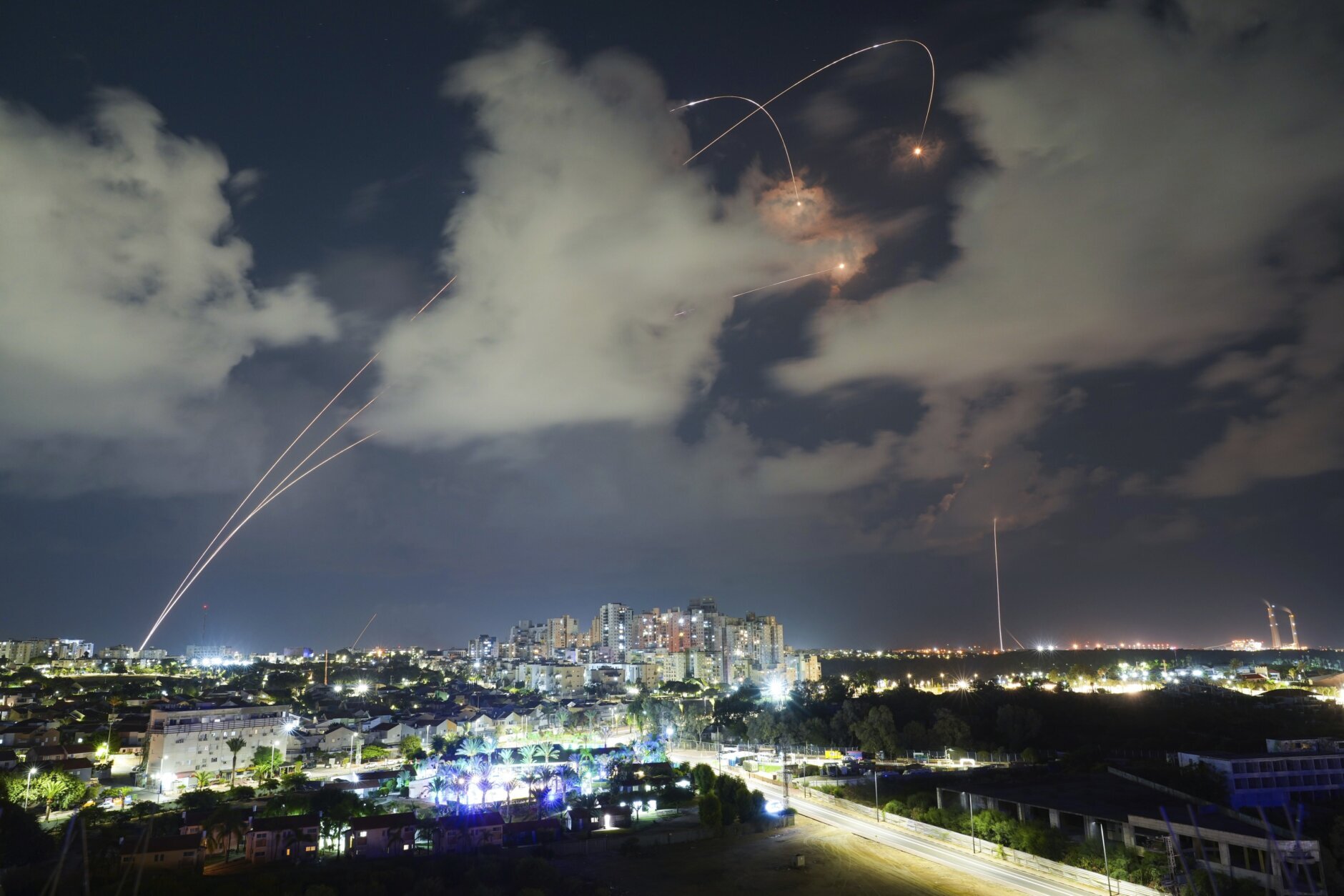
APTOPIX Israel Palestinians Israeli Iron Dome air defense system fires to intercept a rocket fired from the Gaza Strip, in Ashkelon, Israel, Thursday, Oct.19, 2023. (AP Photo/Tsafrir Abayov)
AP Photo/Tsafrir Abayov
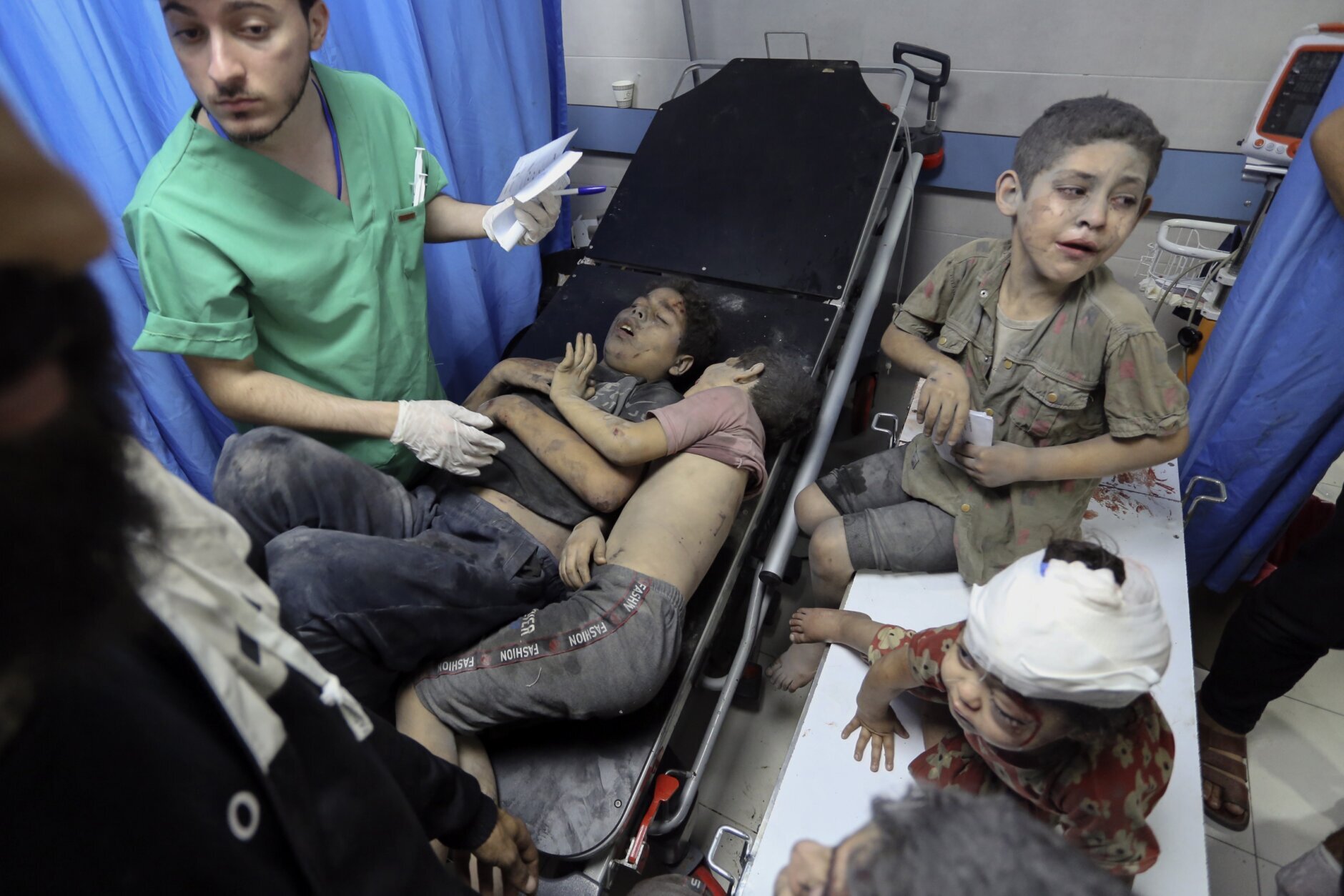
Israel Palestinians Wounded Palestinians arrive at the al-Shifa hospital, following Israeli airstrikes on Gaza City, central Gaza Strip, Thursday, Oct. 19, 2023. (AP Photo/Abed Khaled)
AP Photo/Abed Khaled
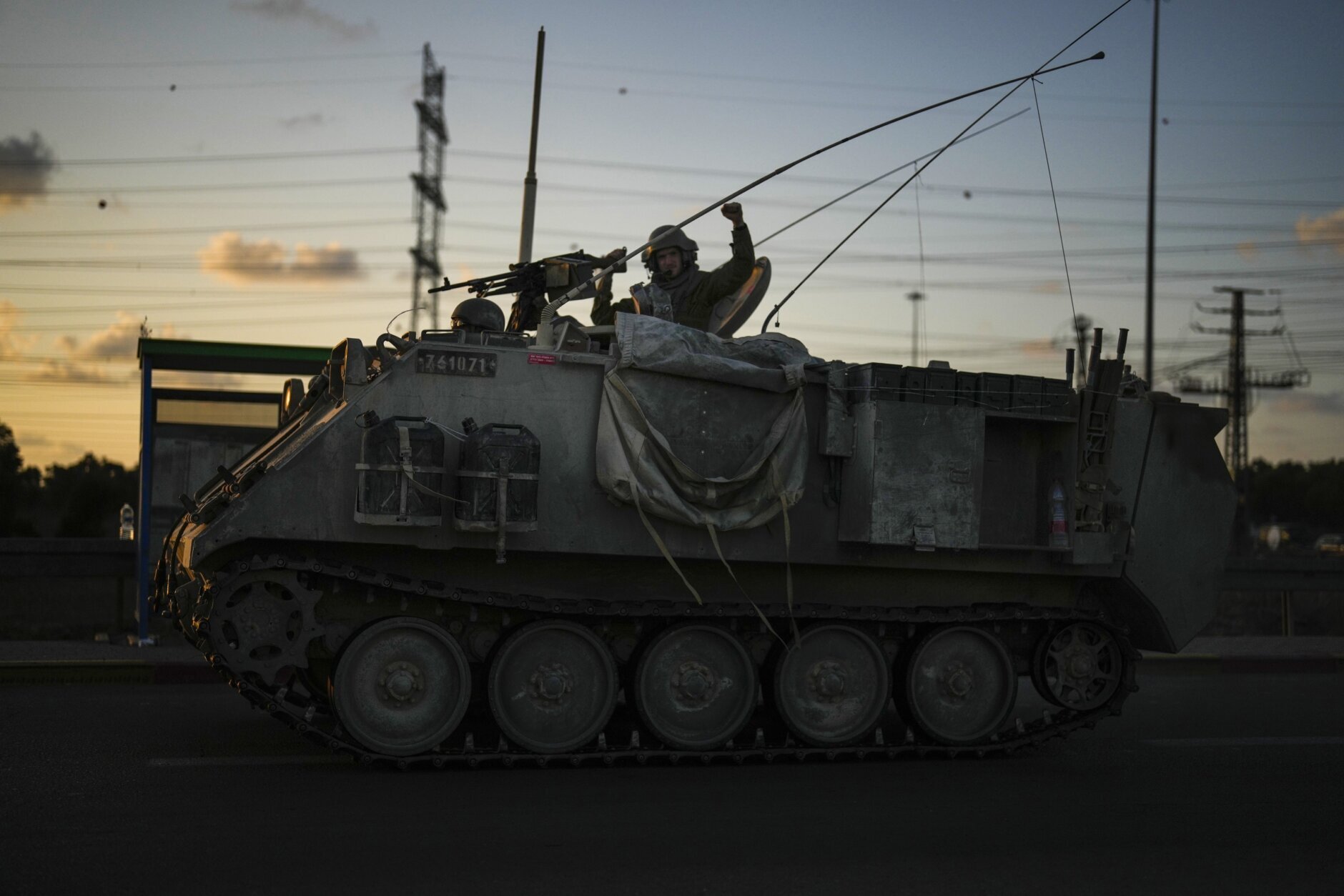
Israel Palestinians An Israel soldier gestures to passers-by as he drives a military vehicle near the border between Israel and Gaza Strip, Israel, Thursday, Oct. 19, 2023. (AP Photo/Francisco Seco)
AP Photo/Francisco Seco
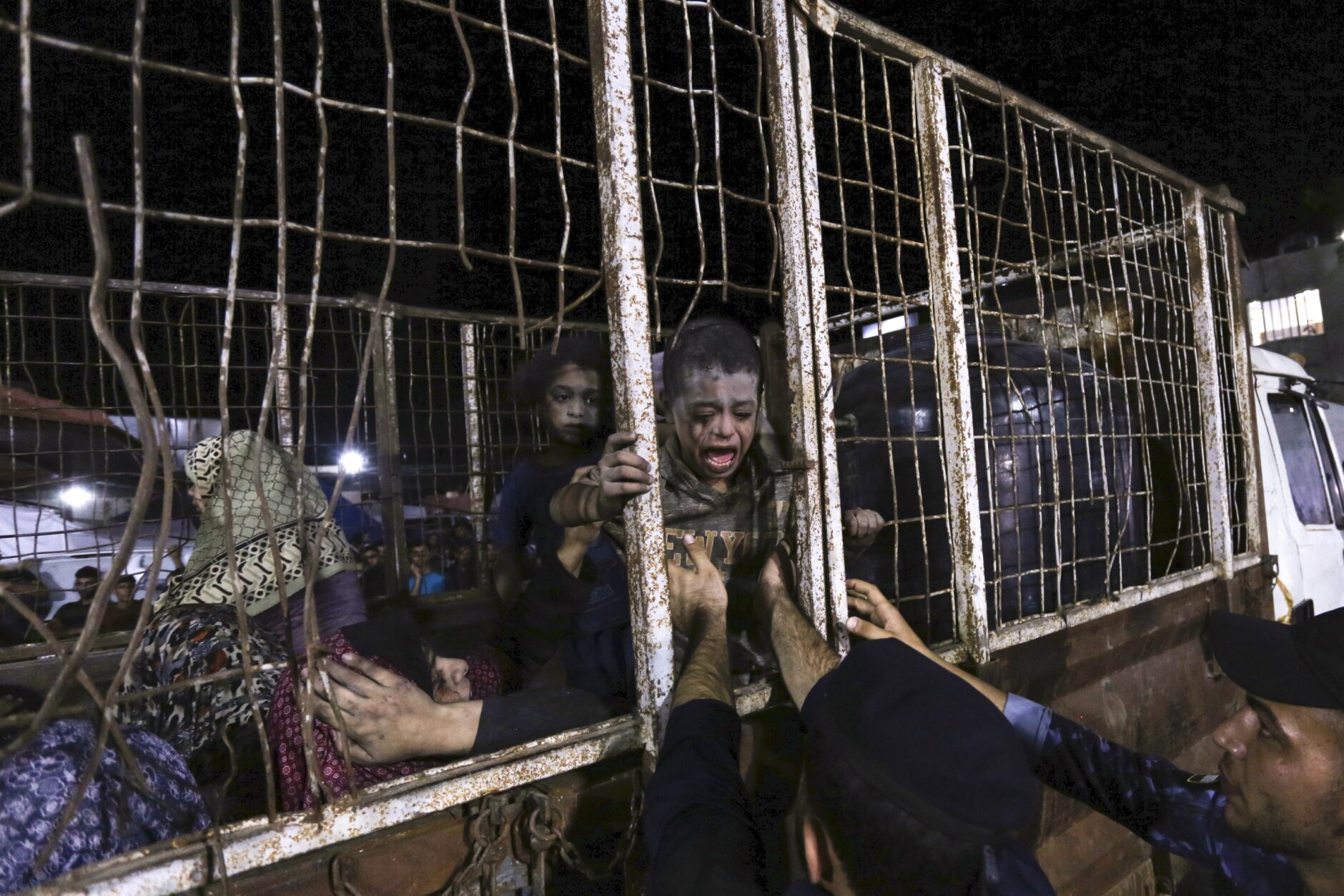
Israel Palestinians Wounded Palestinians arrive at the al-Shifa hospital, on a truck, following Israeli airstrikes on Gaza City, central Gaza Strip, Thursday, Oct. 19, 2023. (AP Photo/Abed Khaled)
AP Photo/Abed Khaled
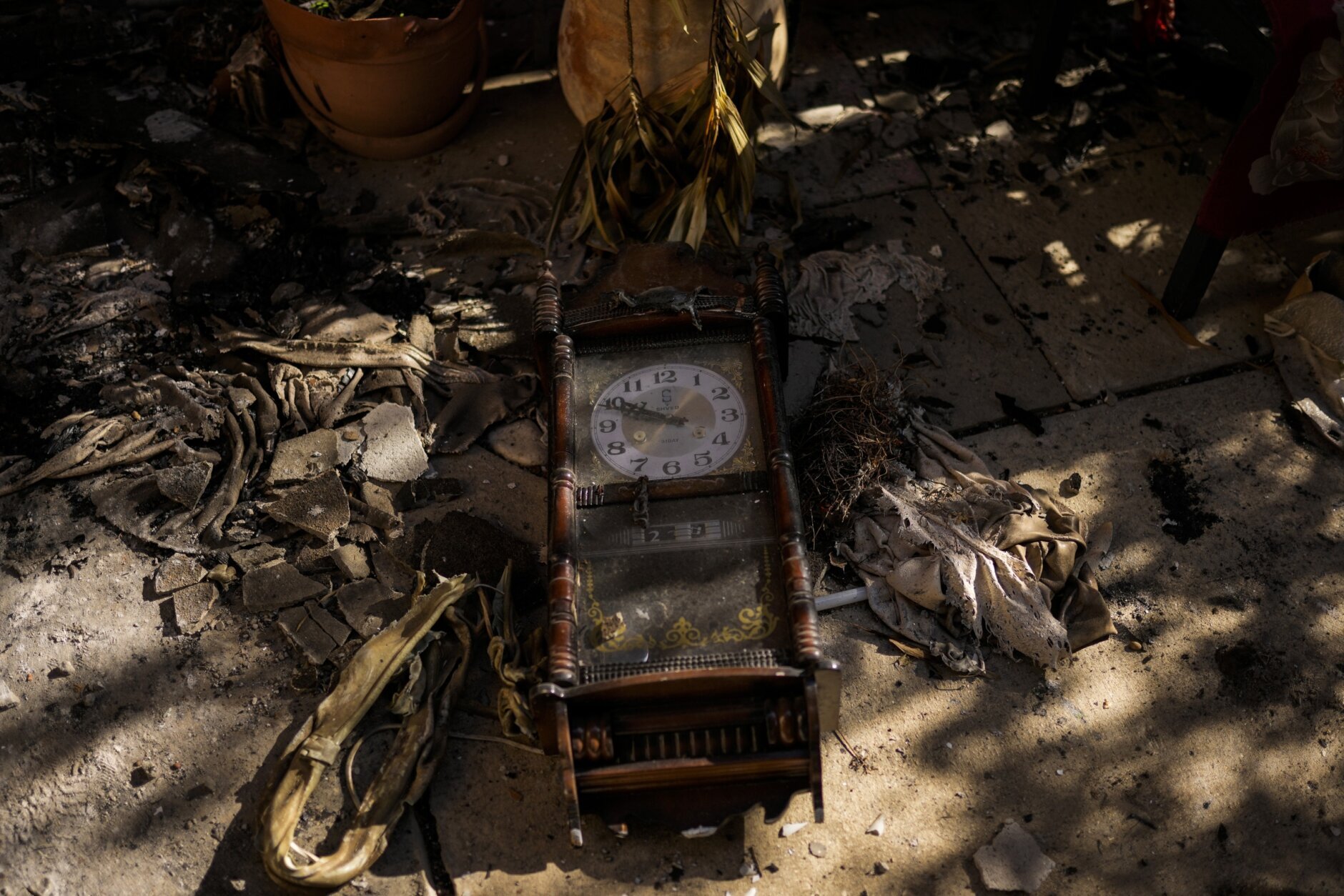
Israel Palestinians A damaged clock outside a home that came under attack during a massive Hamas invasion into Kibbutz Nir Oz, Israel, Thursday, Oct. 19, 2023. The small farming community in the south of Israel was overrun by Hamas fighters from the nearby Gaza Strip who killed 1,400 Israelis and captured dozens of others on Oct. 7. (AP Photo/Francisco Seco)
AP Photo/Francisco Seco
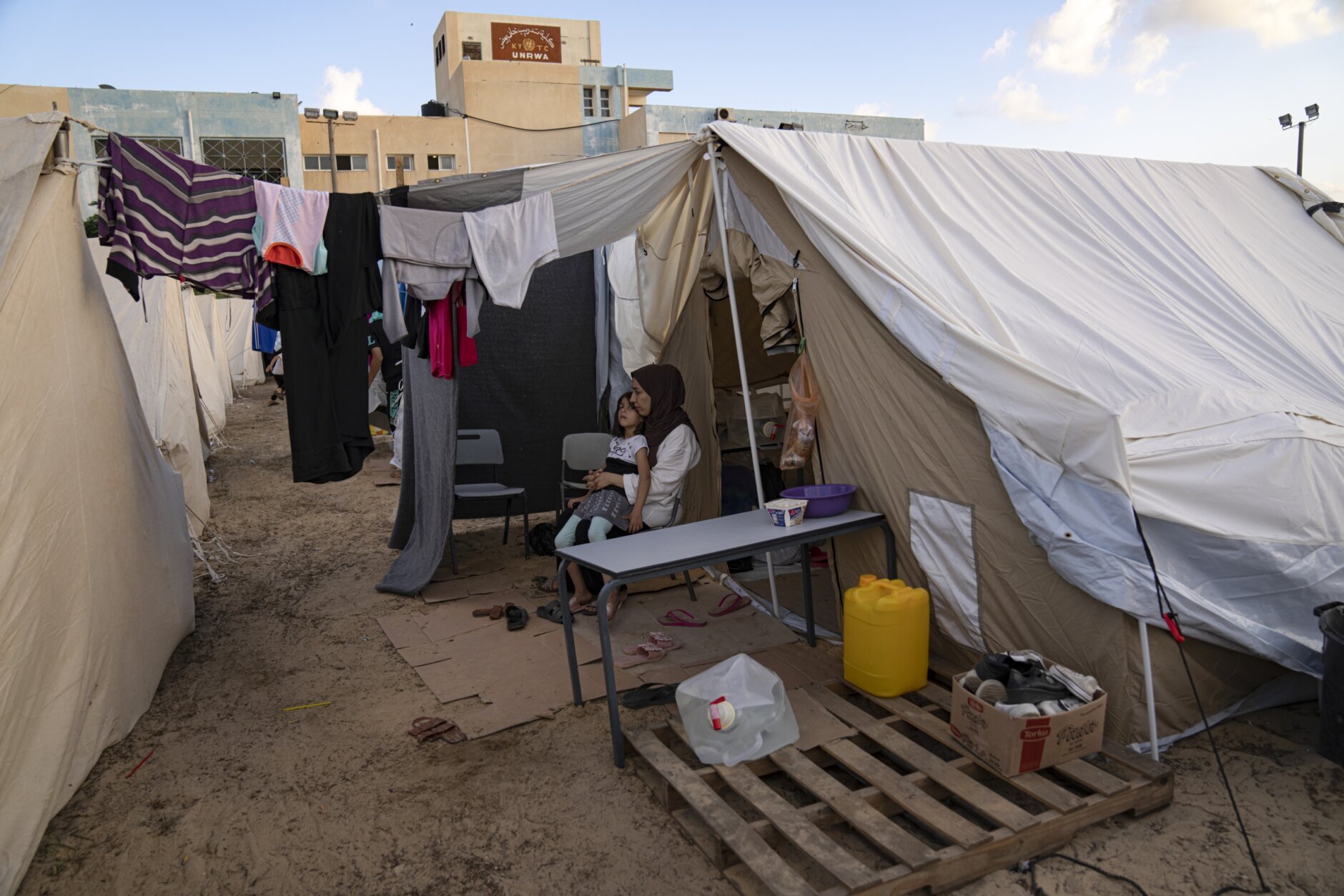
Israel Palestinians Palestinians displaced by the Israeli bombardment of the Gaza Strip sit in a UNDP-provided tent camp in Khan Younis on Thursday, Oct. 19, 2023. (AP Photo/Fatima Shbair)
AP Photo/Fatima Shbair
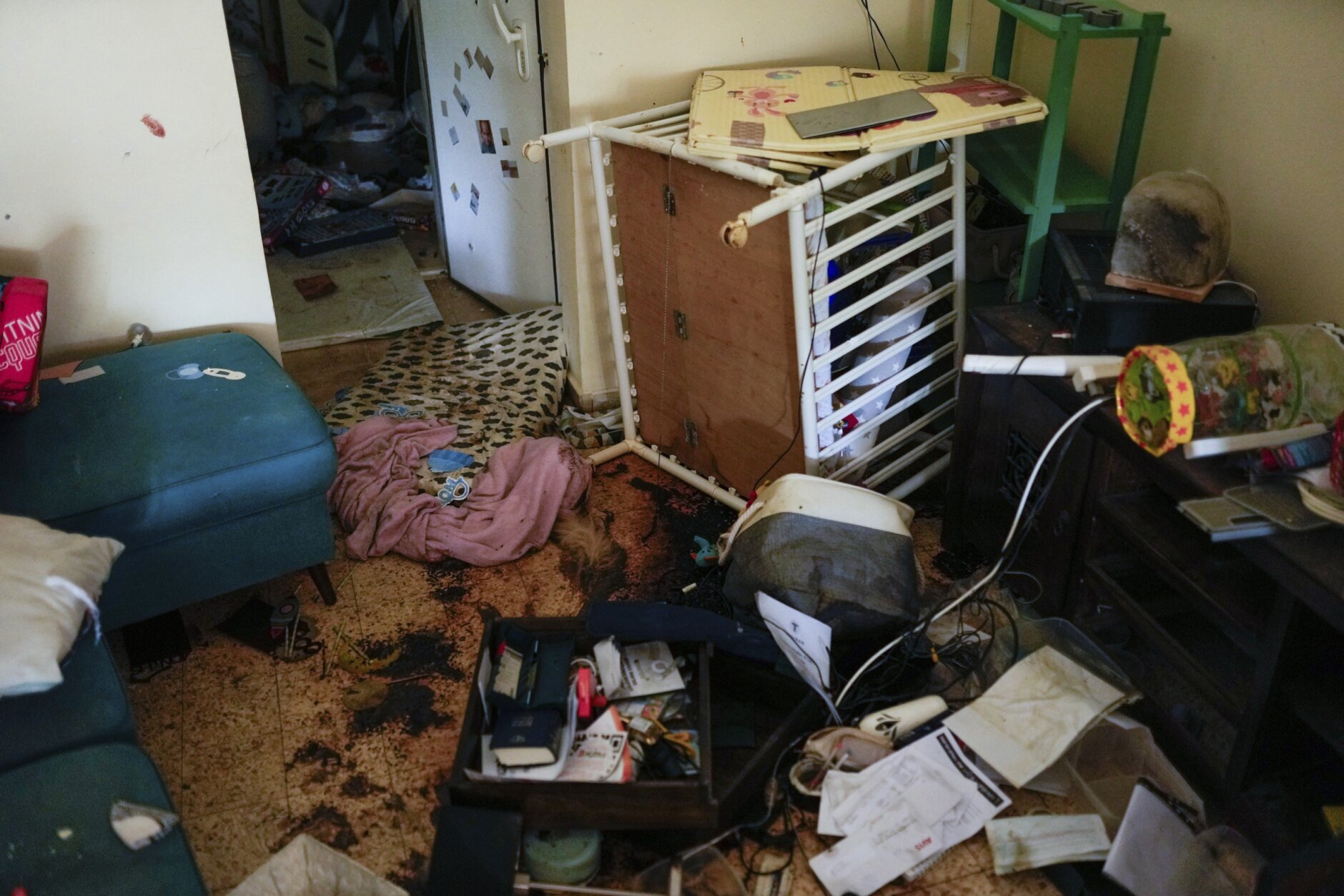
Israel Palestinians EDS NOTE: GRAPHIC CONTENT - Blood is seen splattered in a house following a massive Hamas militant attack in Kibbutz Nir Oz, Israel, Thursday, Oct. 19, 2023. The small farming community in the south of Israeli was overrun by Hamas fighters from the nearby Gaza Strip who killed 1,400 Israelis and captured dozens of others on Oct. 7. (AP Photo/Francisco Seco)
AP Photo/Francisco Seco
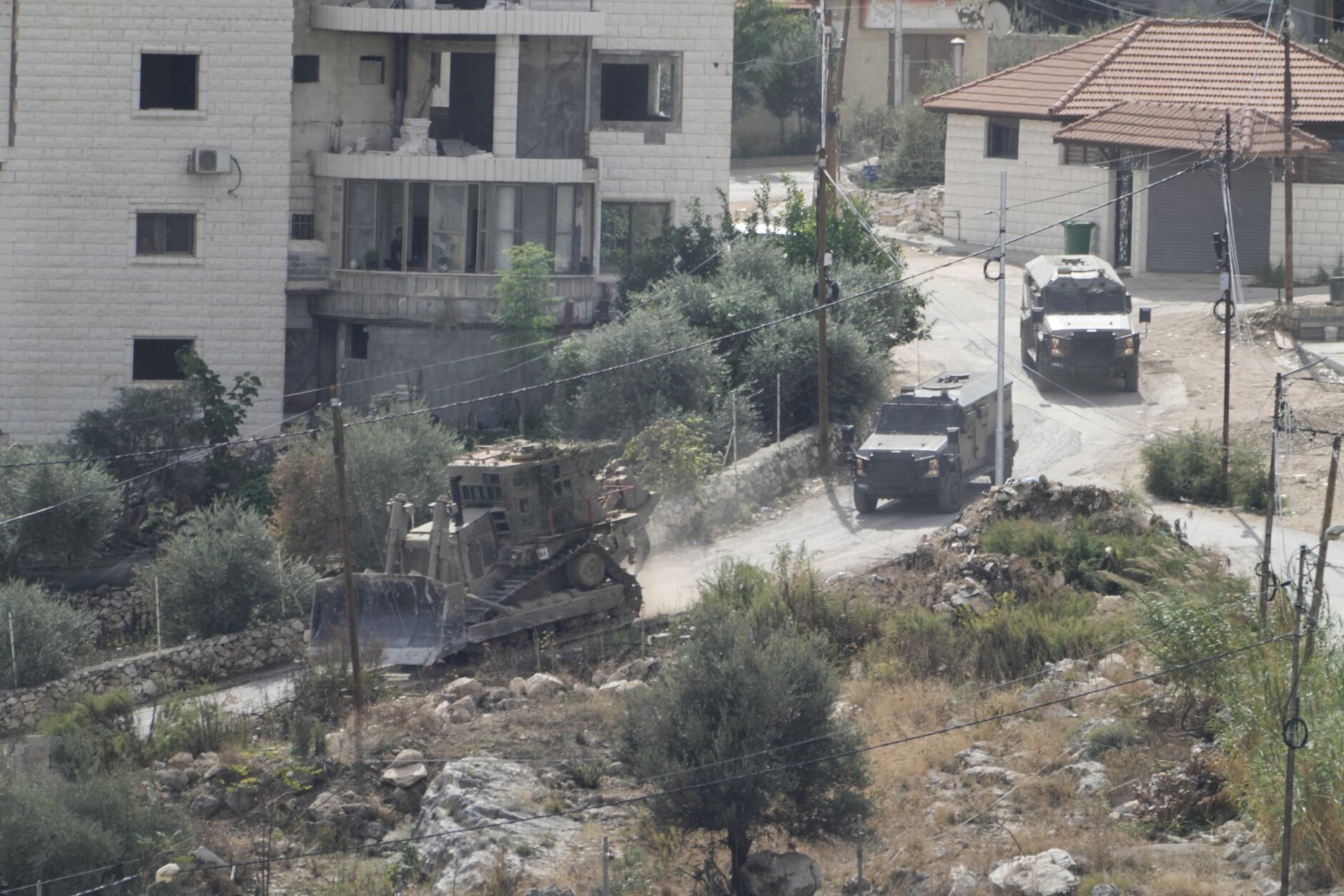
Israel Palestinians Israeli military vehicles are seen during a raid on Nur Shams refugee camp in the West Bank on Thursday, Oct. 19, 2023. (AP Photo/Majdi Mohammed)
AP Photo/Majdi Mohammed
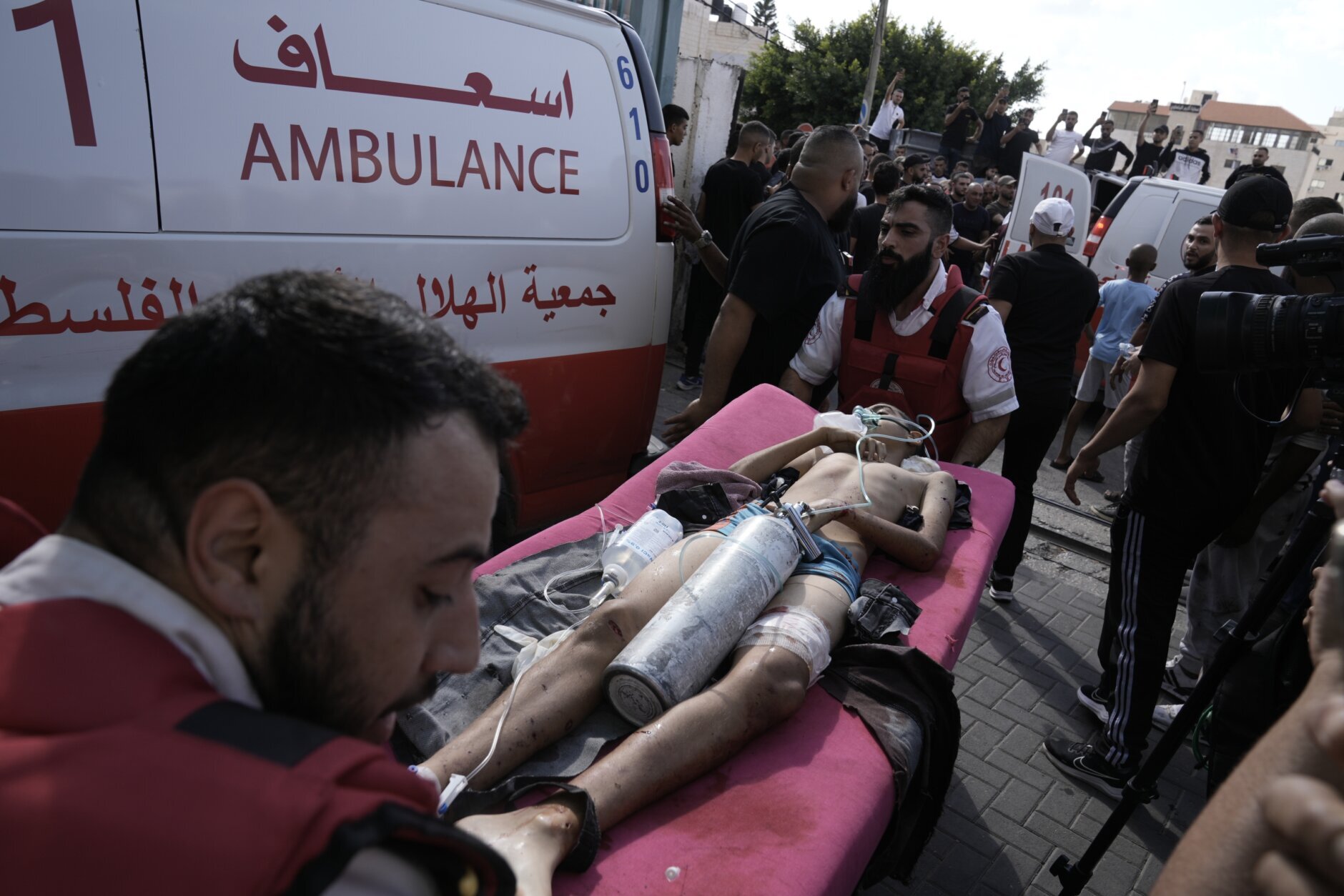
Israel Palestinians A Palestinian boy wounded in an Israeli army raid on Nur Shams refugee camp is brought to a hospital in Tulkarem, West Bank, on Thursday, Oct. 19, 2023. (AP Photo/Majdi Mohammed)
AP Photo/Majdi Mohammed
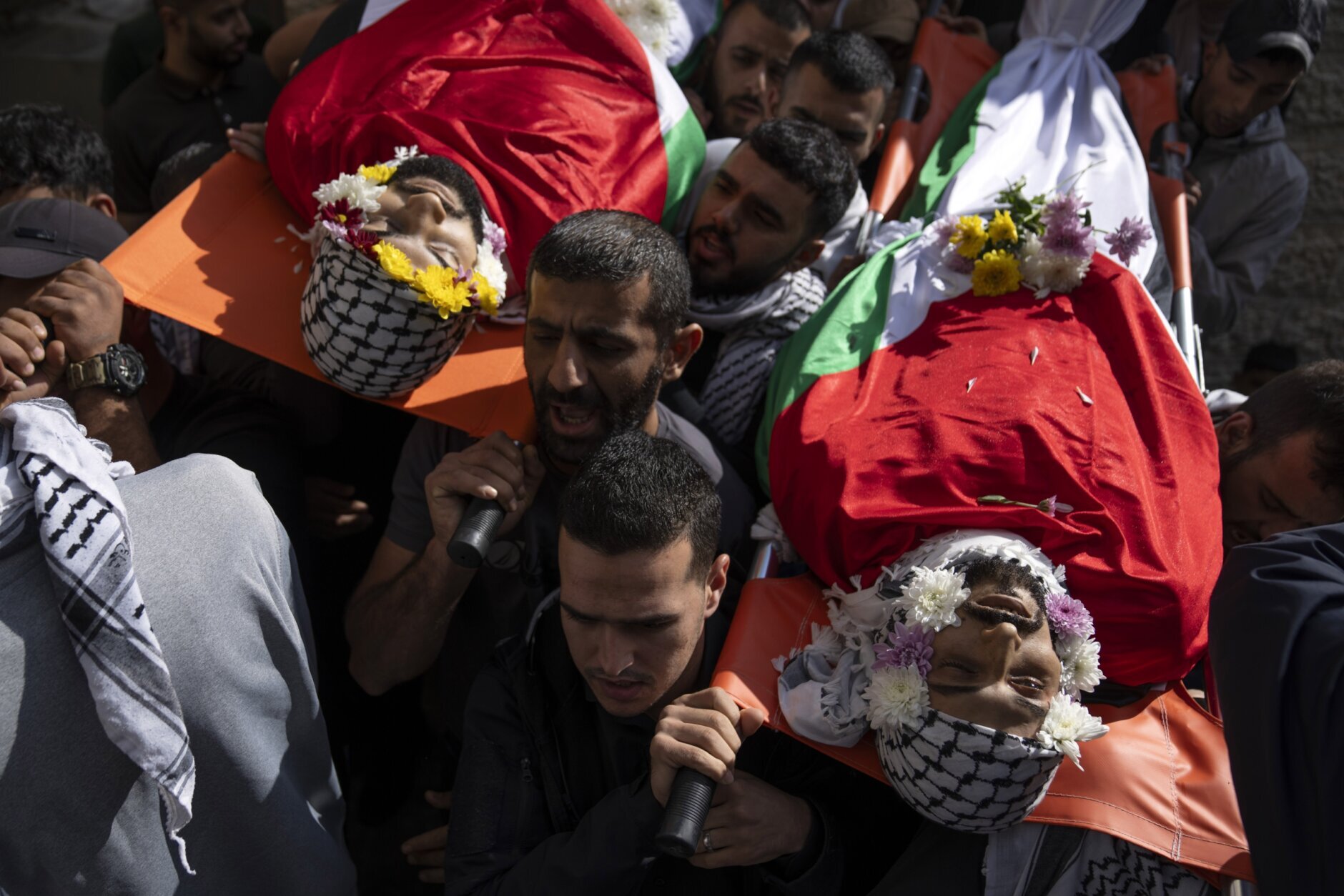
Israel Palestinians Mourners carry the Bodies of Ibrahim Awad, right, and Mohammad Fawaqa, during their funeral in the West Bank city of Ramallah, Thursday, Oct. 19, 2023. Awad was killed during clashes with Israeli settlers near his home village of Dura al-Qara' and Fawaqa was killed during an Israeli army raid in the village of Qebia, west of Ramallah, while two other Palestinians were killed during Israeli army raids early morning in the occupied West Bank, Palestinian ministry of health said. (AP Photo/Nasser Nasser)
AP Photo/Nasser Nasser
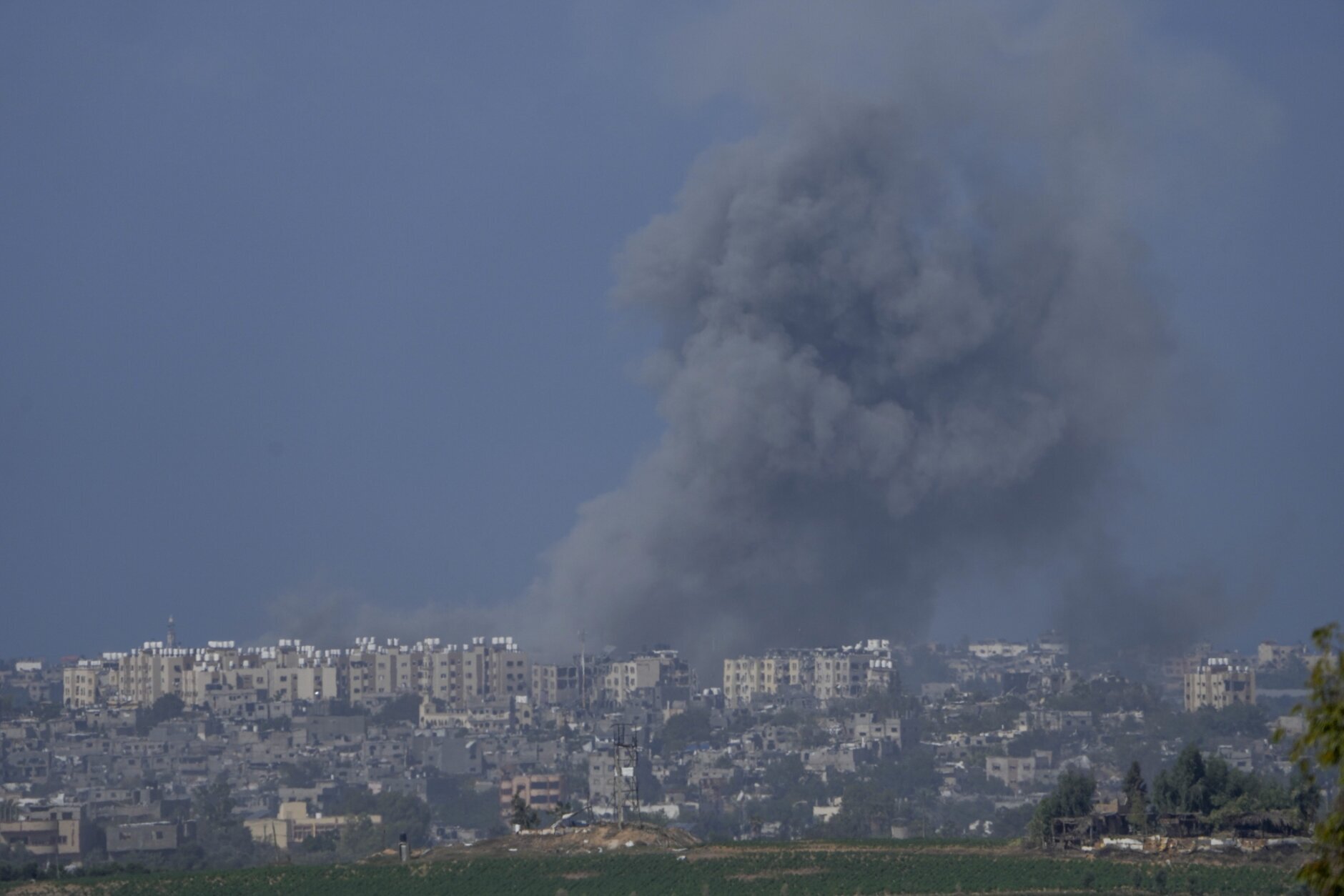
Israel Palestinians Smoke rises following an Israeli airstrike in the Gaza Strip, as seen from southern Israel, Thursday, Oct. 19, 2023. (AP Photo/Maya Alleruzzo)
AP Photo/Maya Alleruzzo
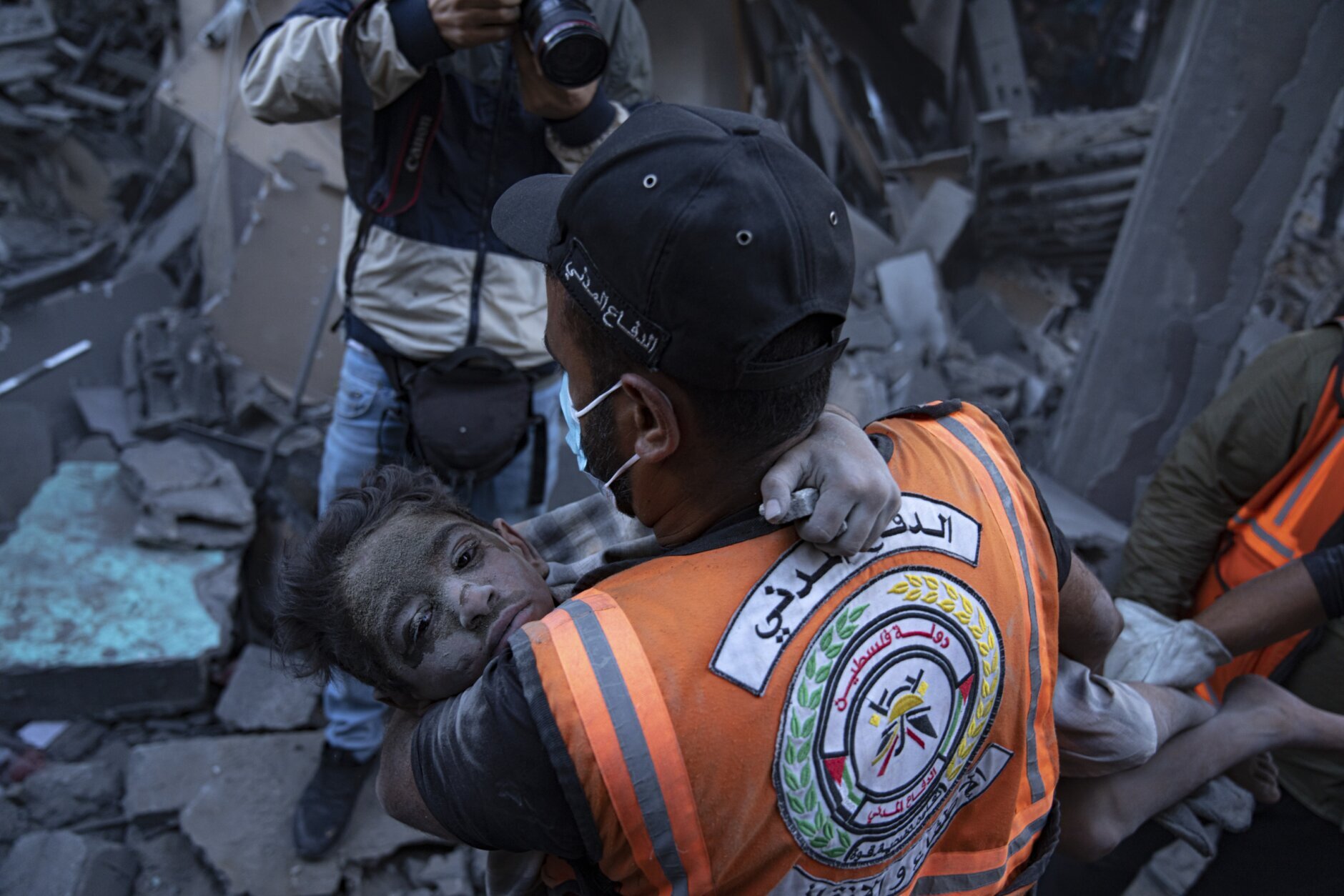
APTOPIX Palestinians Israel Palestinians evacuate wounded from a building destroyed in Israeli bombardment in Khan Younis, Gaza Strip, Thursday, Oct. 19, 2023. (AP Photo/Fatima Shbair)
AP Photo/Fatima Shbair
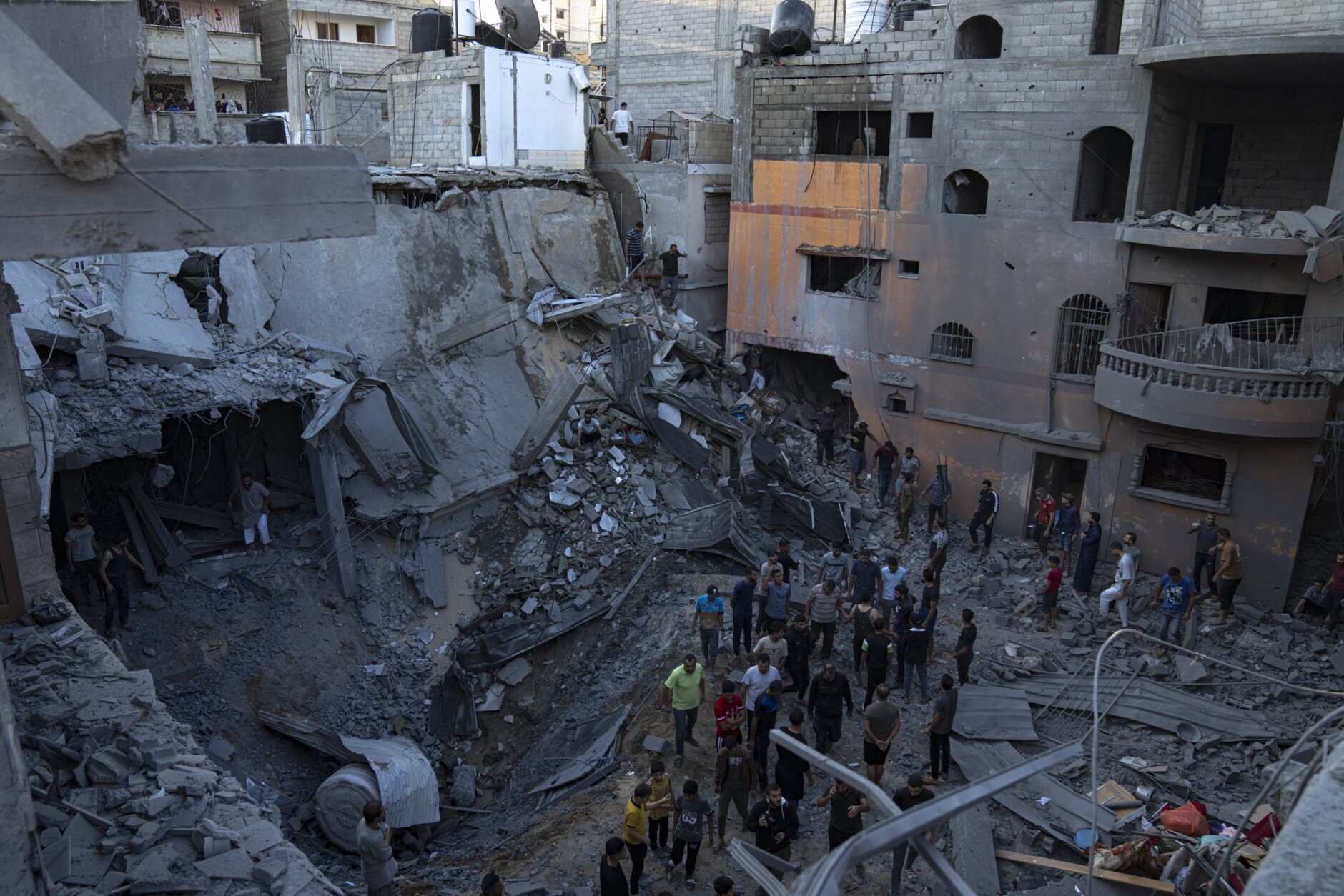
Palestinians Israel Palestinians search for survivors from a building destroyed in Israeli bombardment in Khan Younis, Gaza Strip, Thursday, Oct. 19, 2023. (AP Photo/Fatima Shbair)
AP Photo/Fatima Shbair
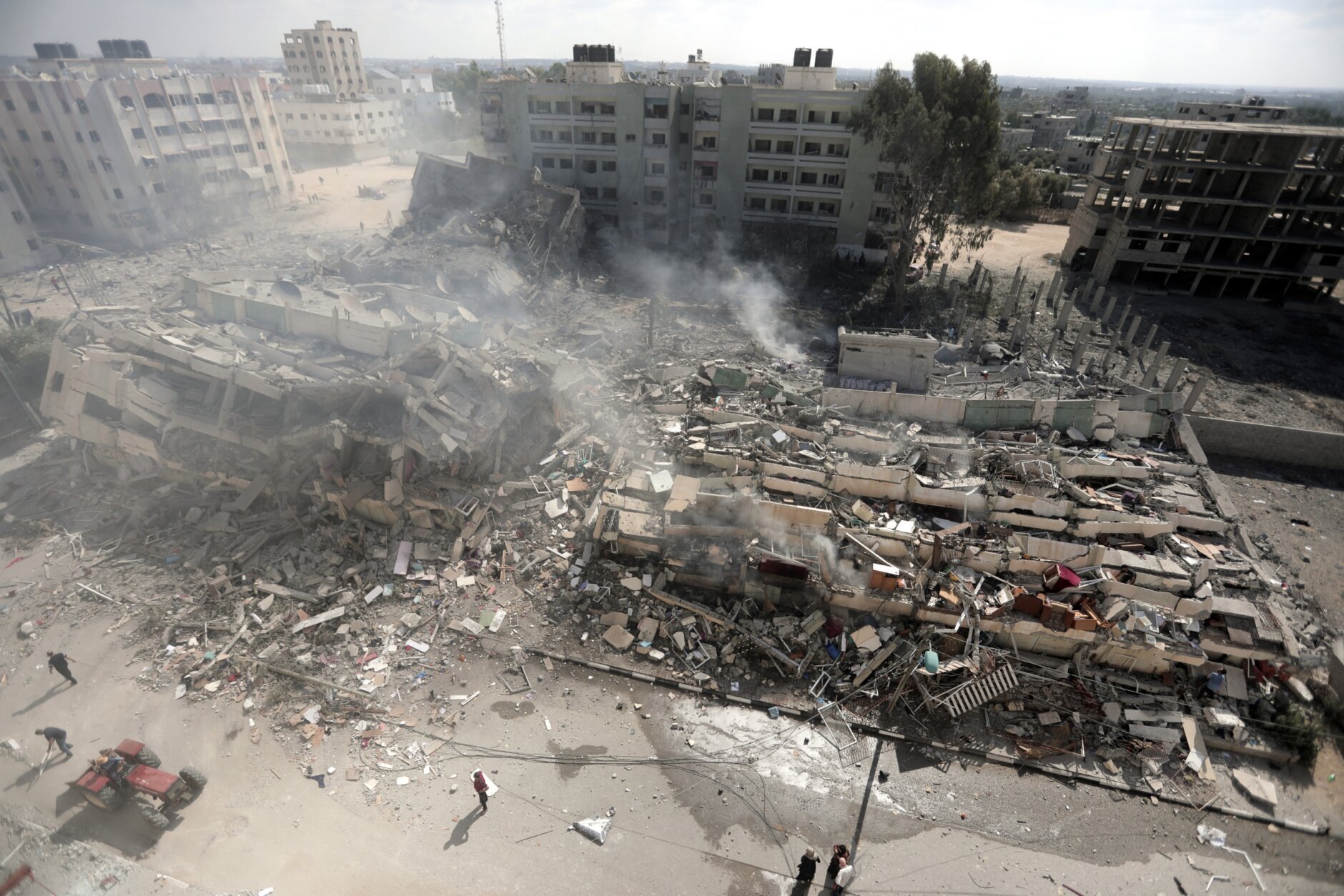
Israel Palestinians Smoke rises from destroyed buildings, following Israeli airstrikes on Gaza City, central Gaza Strip, Thursday, Oct. 19, 2023. (AP Photo/Mohammed Dahman)
AP Photo/Mohammed Dahman
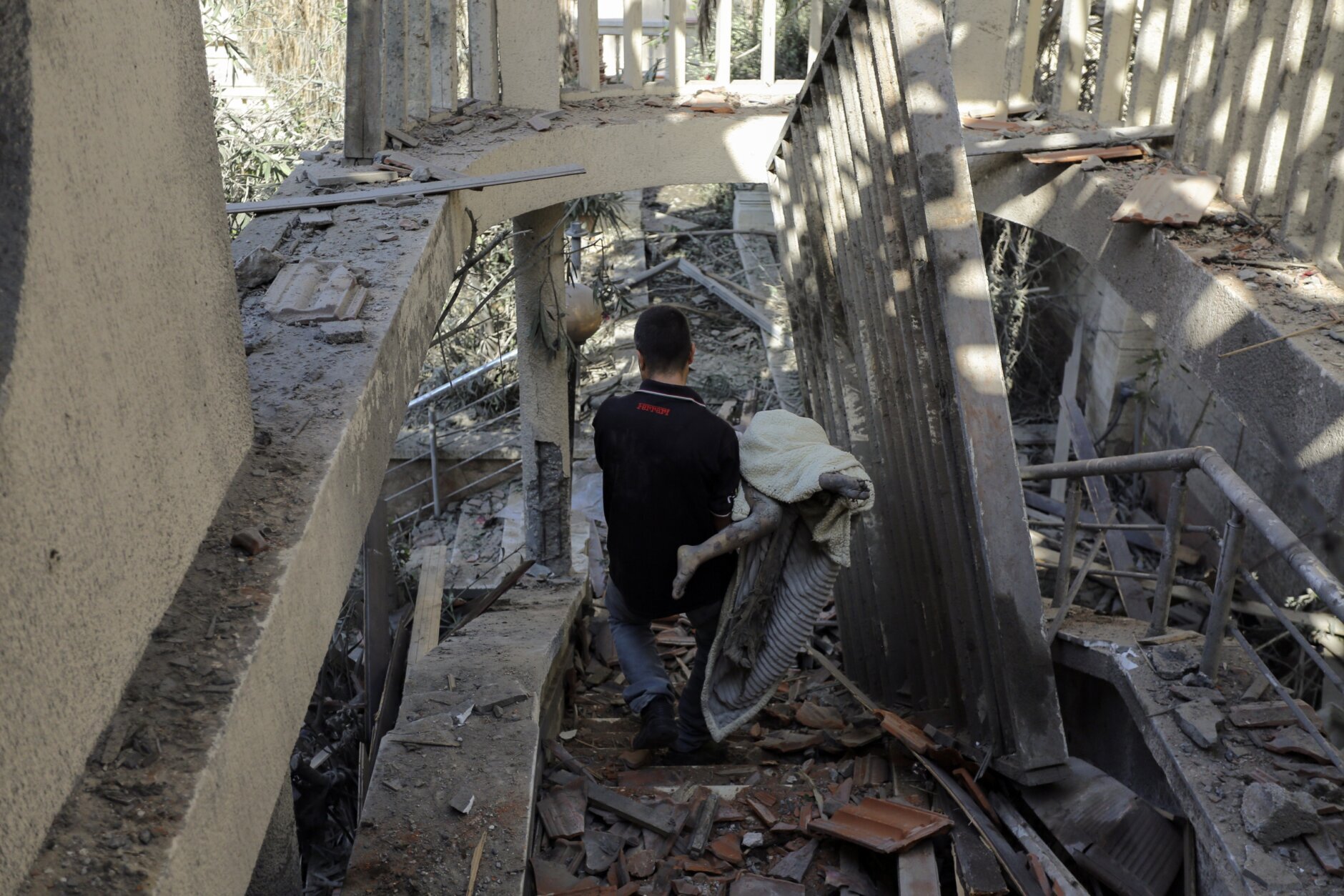
Israel Palestinians A Palestinian man carries a body found inside a destroyed house following Israeli airstrikes on Gaza City, Thursday, Oct.19, 2023. (AP Photo/Abed Khaled)
AP Photo/Abed Khaled
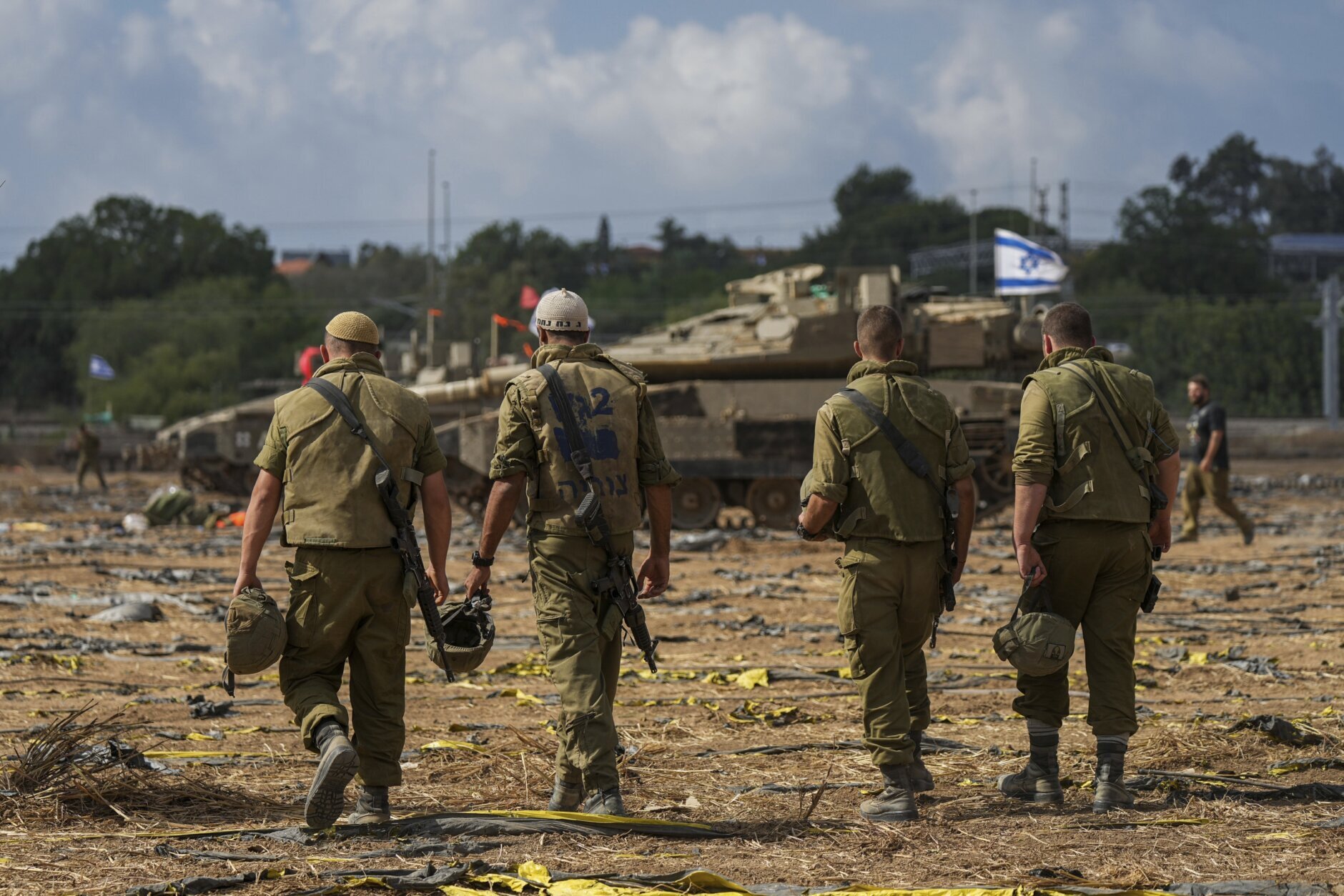
Israel Palestinians Israeli soldiers gather in a staging area near the border with Gaza Strip, in southern Israel, Thursday, Oct. 19, 2023. (AP Photo/Tsafrir Abayov)
AP Photo/Tsafrir Abayov
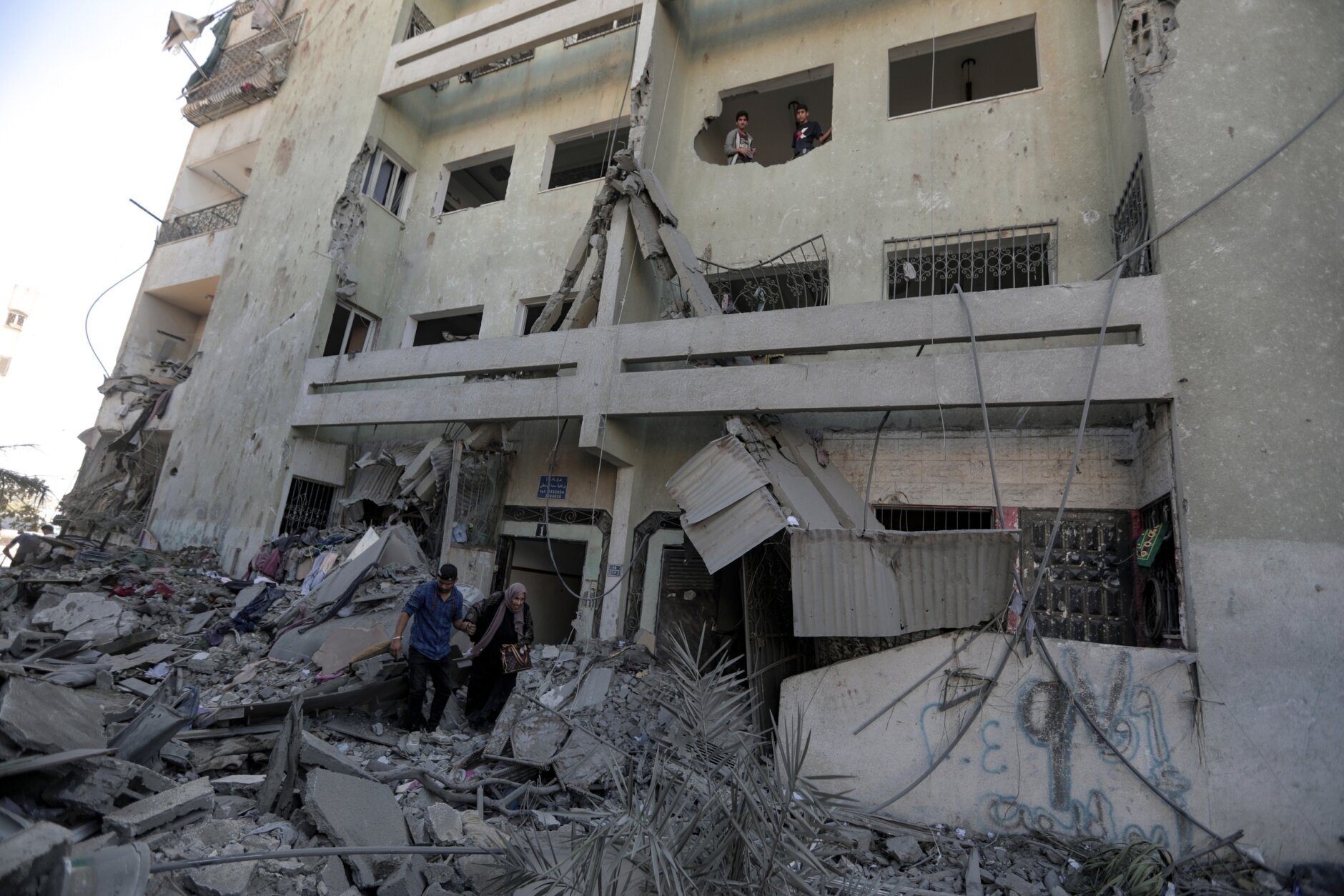 Israel Palestinians Palestinians leave a partially destroyed building following Israeli airstrikes on Gaza City, central Gaza Strip, Thursday, Oct. 19, 2023. (AP Photo/Mohammed Dahman)
Israel Palestinians Palestinians leave a partially destroyed building following Israeli airstrikes on Gaza City, central Gaza Strip, Thursday, Oct. 19, 2023. (AP Photo/Mohammed Dahman)
AP Photo/Mohammed Dahman
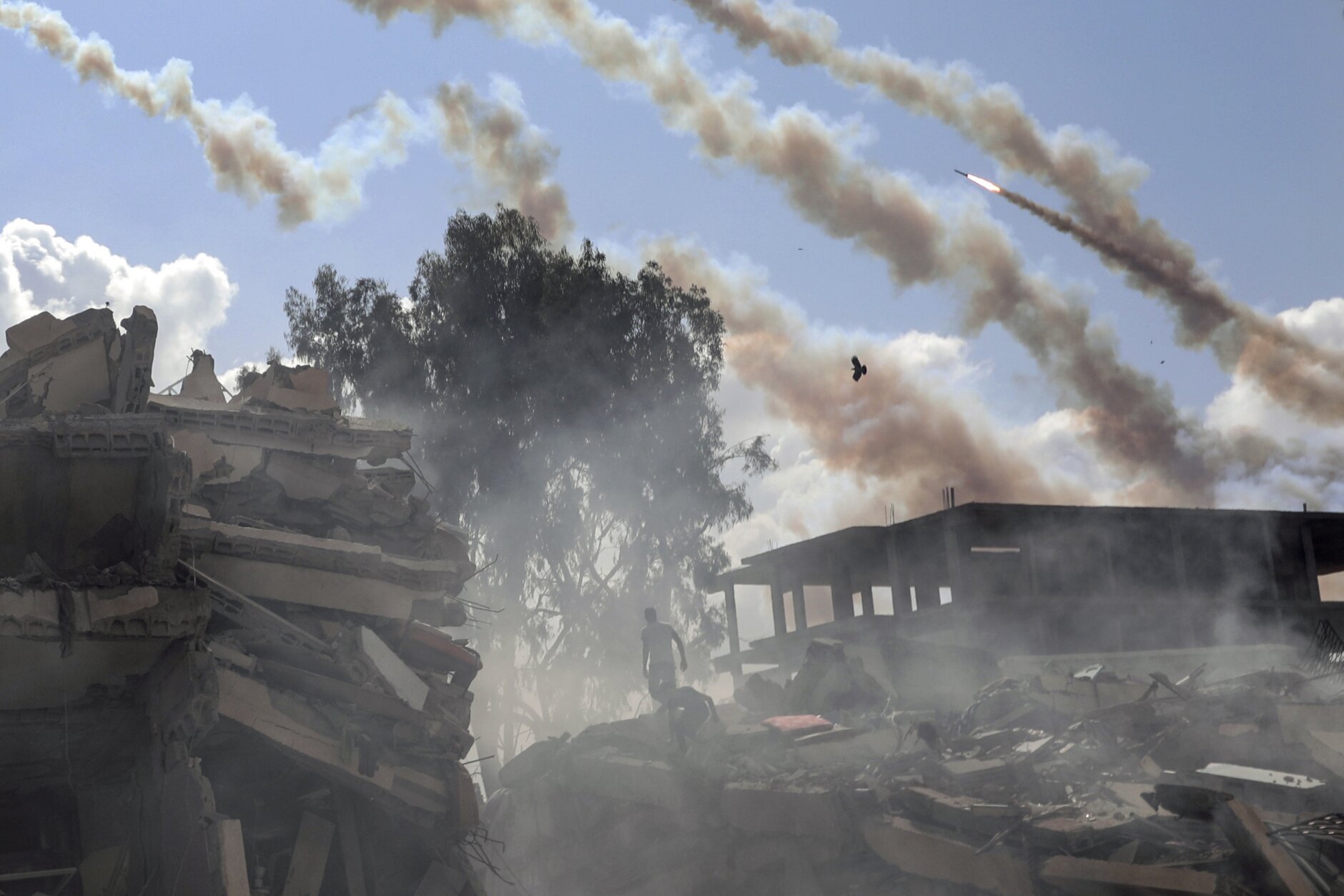
APTOPIX Israel Palestinians Rockets are fired from the Gaza Strip toward Israel over destroyed buildings following Israeli airstrikes on Gaza City, central Gaza Strip, Thursday, Oct. 19, 2023. (AP Photo/Mohammed Dahman)
AP Photo/Mohammed Dahman
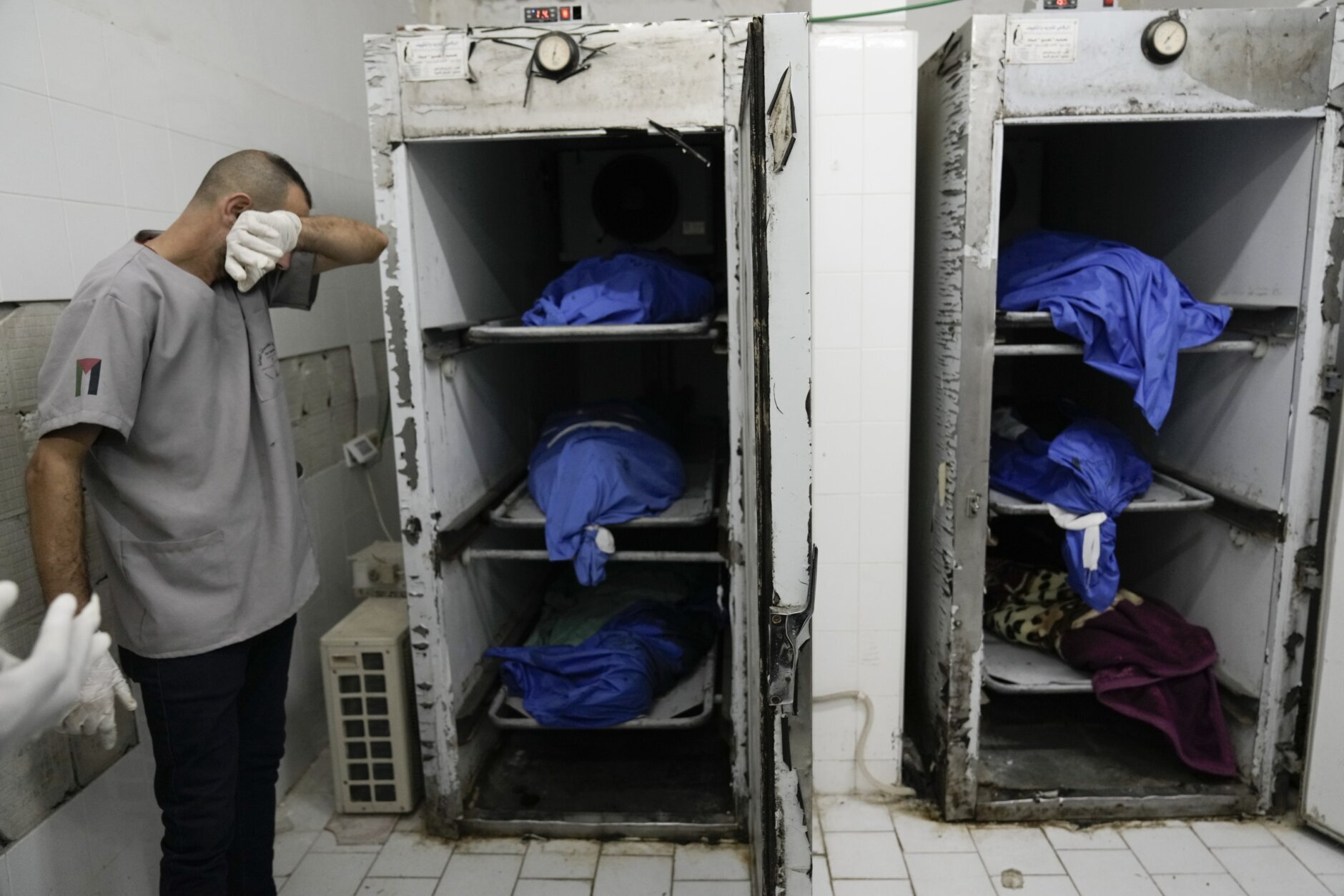
Israel Palestinians Bodies of Palestinians killed during Israeli army raid on Nur Smas refugee camp are seen in a morgue in Tulkarem, West Bank, Thursday, Oct. 19, 2023. (AP Photo/Majdi Mohammed)
AP Photo/Majdi Mohammed
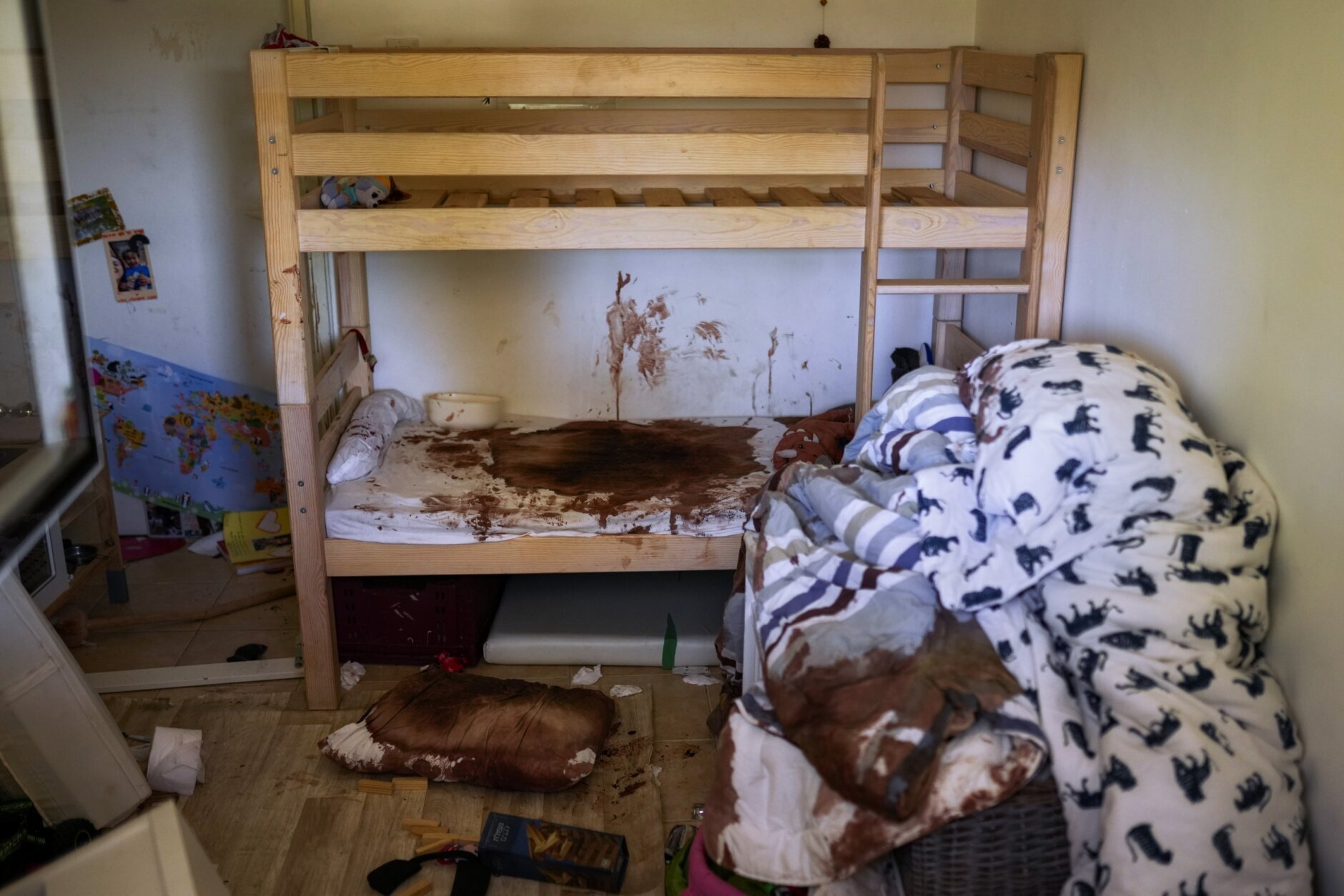
APTOPIX Israel Palestinians EDS NOTE: GRAPHIC CONTENT - Blood is seen splattered in a child's room following a massive Hamas militant attack in Kibbutz Nir Oz, Israel, Thursday, Oct. 19, 2023. The small farming community in the south of Israeli was overrun by Hamas fighters from the nearby Gaza Strip who killed 1,400 Israelis and captured dozens of others on Oct. 7. (AP Photo/Francisco Seco)
AP Photo/Francisco Seco
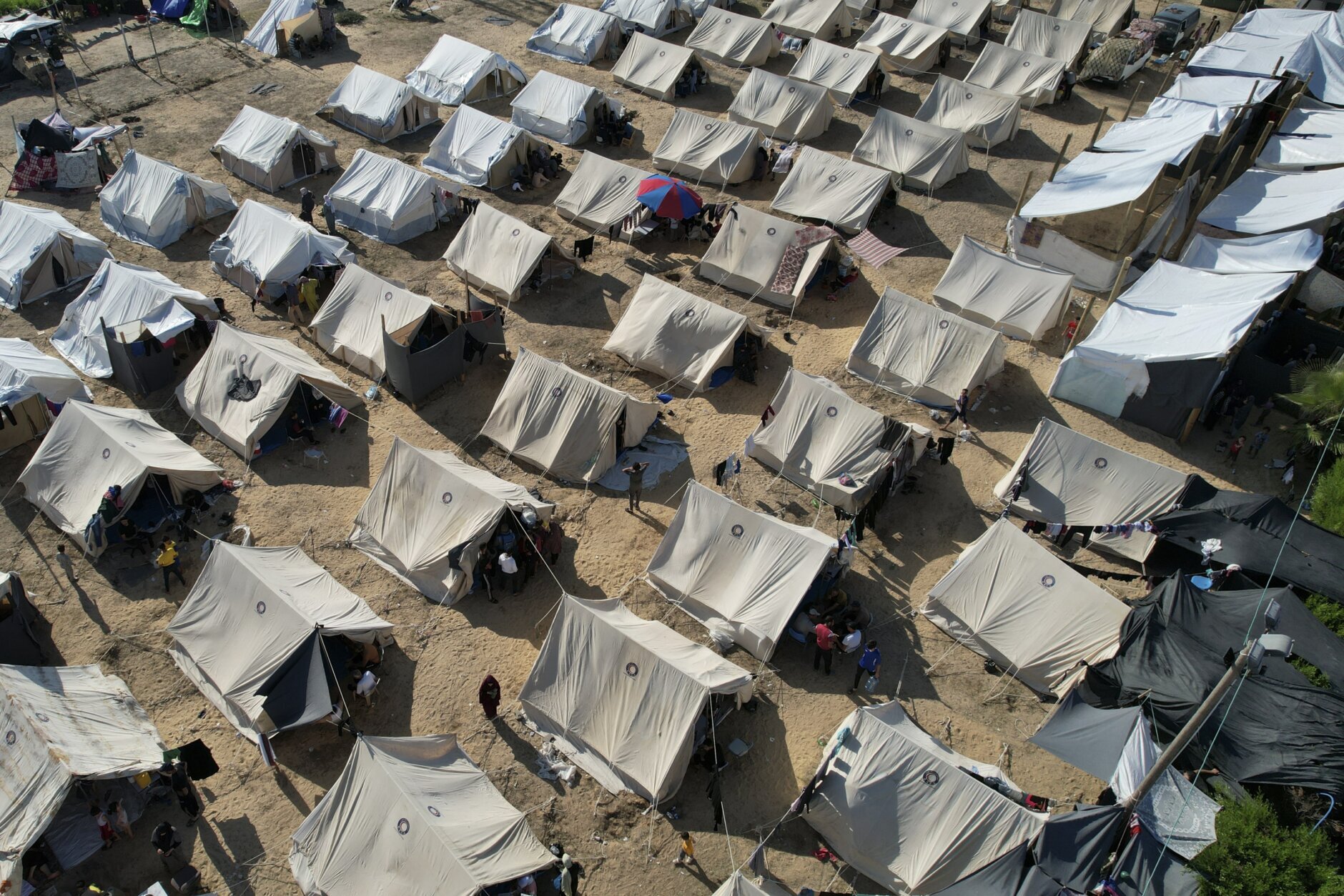
Israel Palestinians UNDP provided tens set up for Palestinians displaced by the Israeli bombardment of the Gaza Strip, are seen in Khan Younis on Thursday, Oct. 19, 2023. (AP Photo/Ashraf Amra)
AP Photo/Ashraf Amra
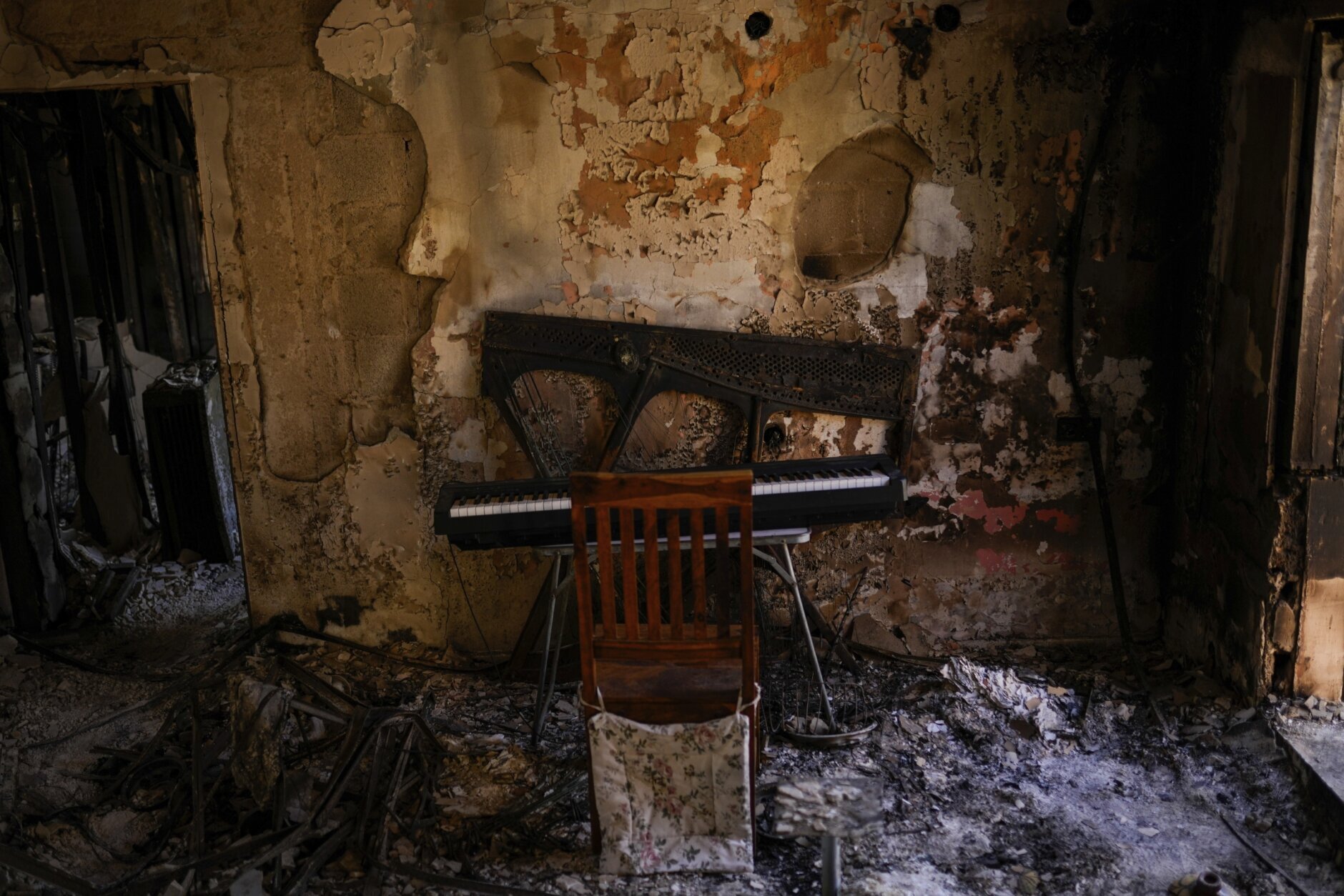
Israel Palestinians Destroyed furniture and charred walls are seen in a home that came under attack during a massive Hamas invasion into Kibbutz Nir Oz, Israel, Thursday, Oct. 19, 2023. The small farming community in the south of Israel was overrun by Hamas fighters from the nearby Gaza Strip who killed 1,400 Israelis and captured dozens of others on Oct. 7. (AP Photo/Francisco Seco)
AP Photo/Francisco SecoNext(7/40)
P
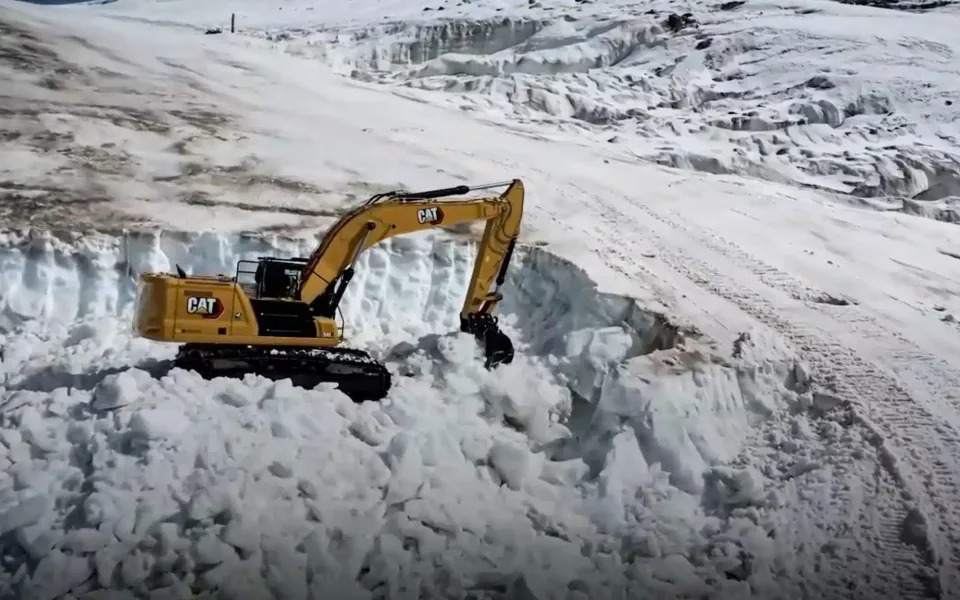
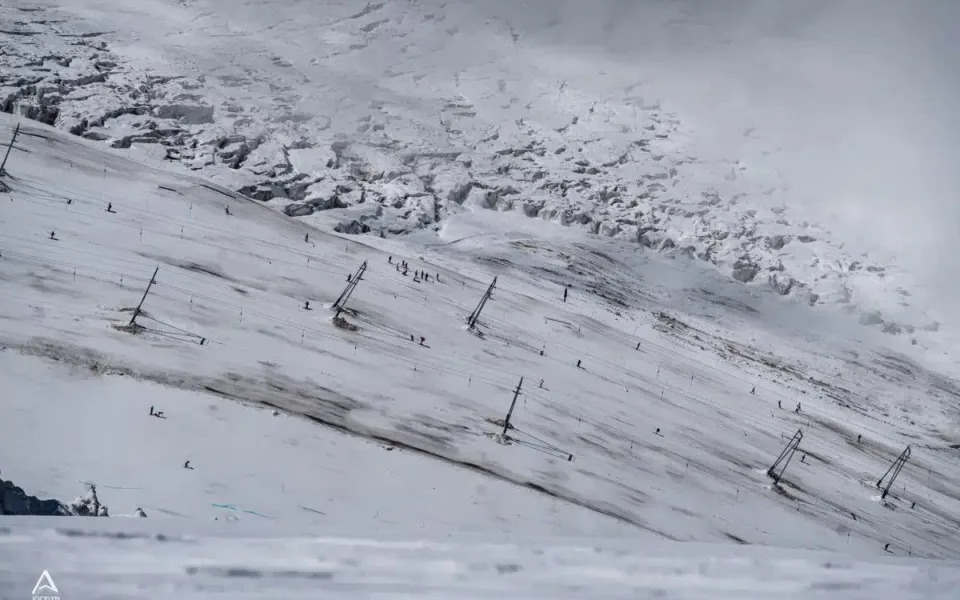


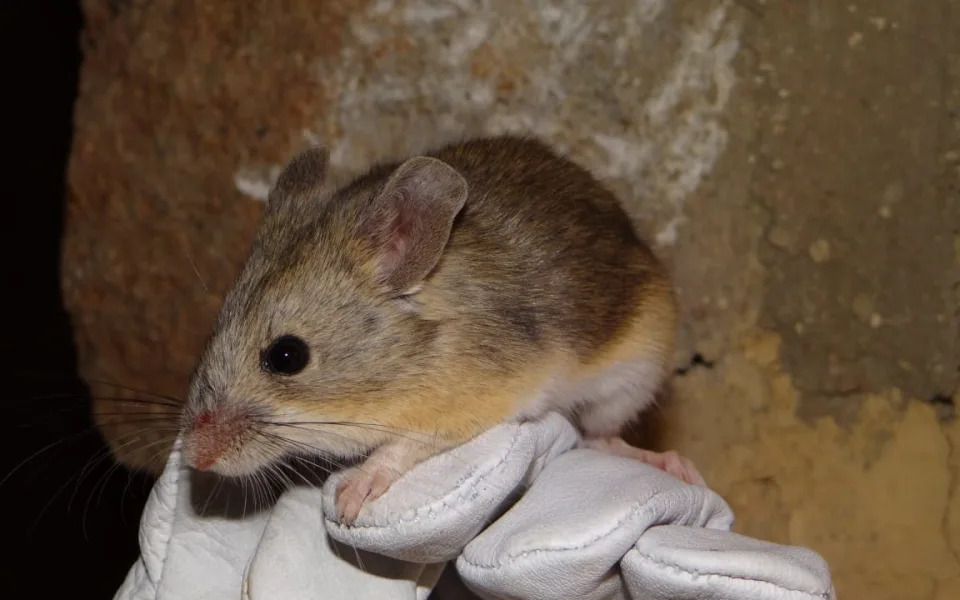


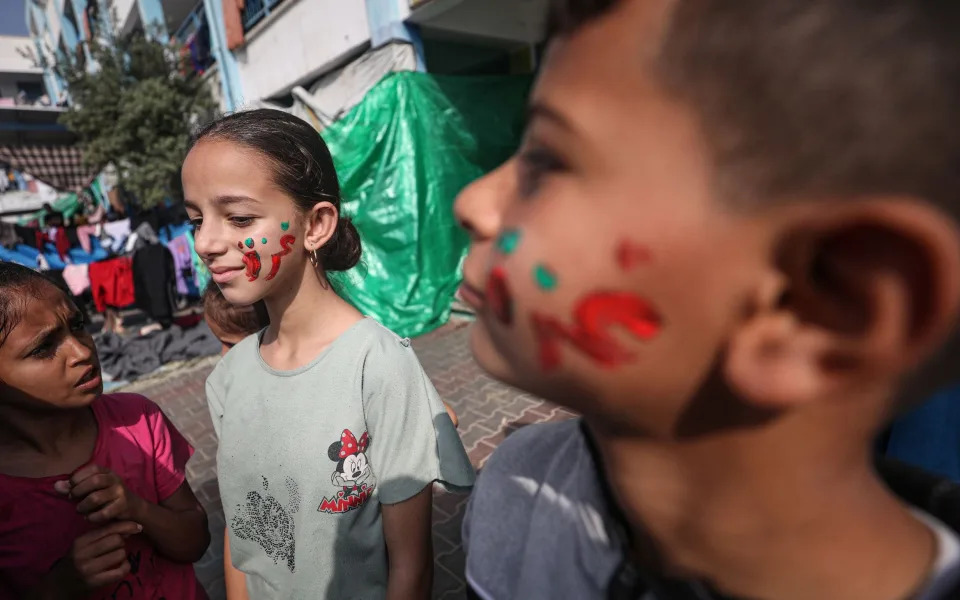
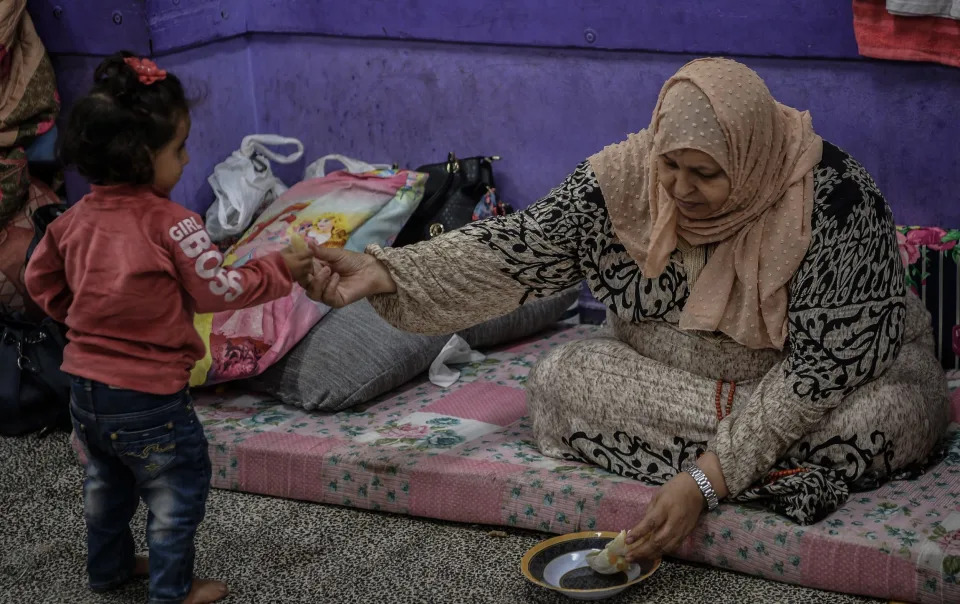
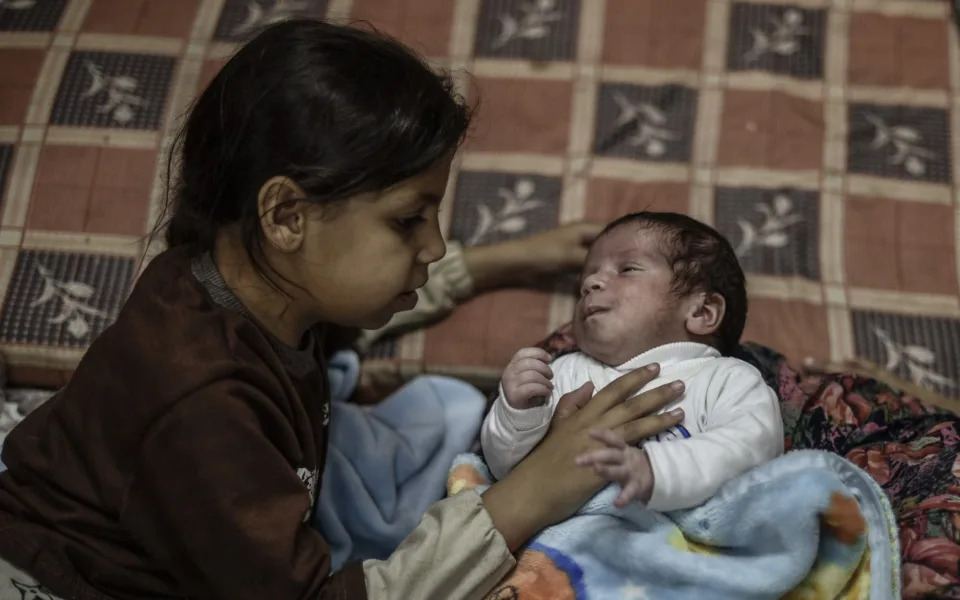
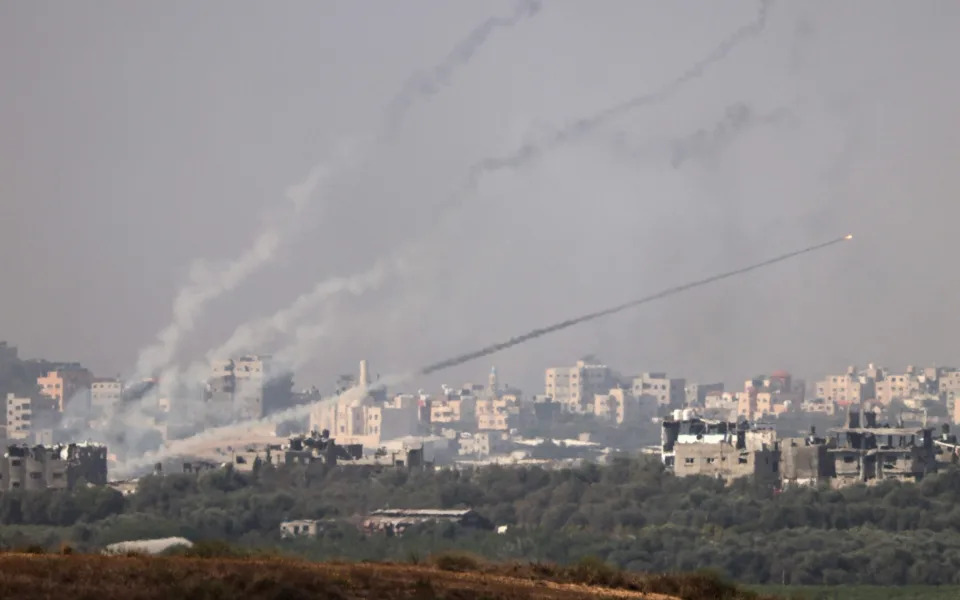

 I
I































 Israel Palestinians Palestinians leave a partially destroyed building following Israeli airstrikes on Gaza City, central Gaza Strip, Thursday, Oct. 19, 2023. (AP Photo/Mohammed Dahman)
Israel Palestinians Palestinians leave a partially destroyed building following Israeli airstrikes on Gaza City, central Gaza Strip, Thursday, Oct. 19, 2023. (AP Photo/Mohammed Dahman)



